No-one does materials technology quite like Mother Nature. Combine an infinite mix of substances with tectonic pressures, volcanic heat and endless patience and it is little wonder that we cannot yet match the beauty of natural science, well before we begin mixing life into the equation. We’re beginning to see COVID-induced change in the elite global auction industry as auction rooms become entirely virtual, and over the next few weeks a fresh round of science and technology sales take place.
Both Christie’s and Bonhams have science-related auctions closing on May 21, and for those who have been looking at the same four walls for the last two months and thinking about potential change in their habitat, here’s a quick look at the best ideas on offer from those auctions.
Fossilized palm leaves and fish
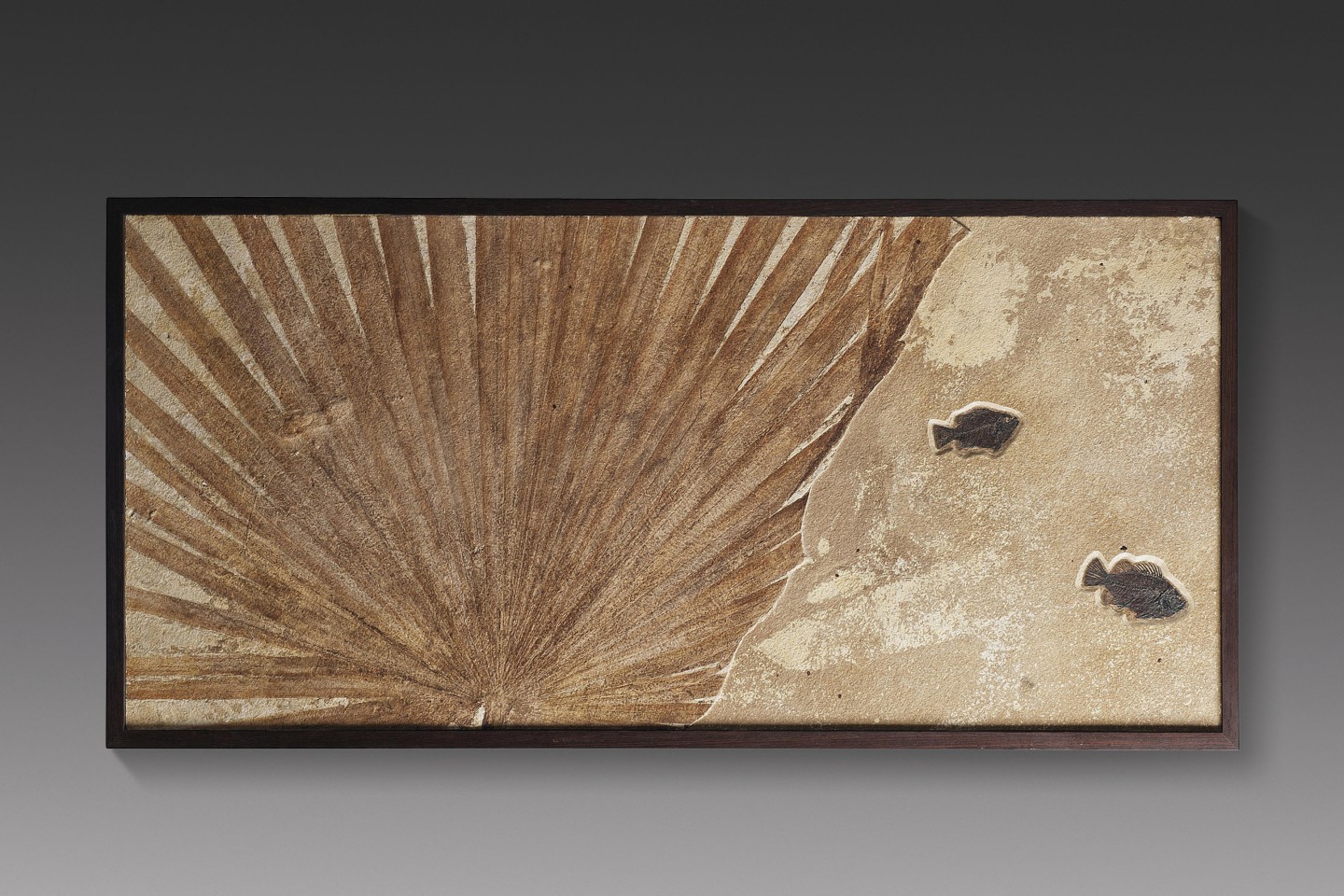
Christie’s
Christies Lot 38, May 21, 2020
Estimate: £10,000 – £15,000 (US$12,500 – US$18,750)
From the famous Green River Basin comes this remarkable Eocene (circa 50 million years ago) period wall hanging.
Framed mosasaur skull & neck
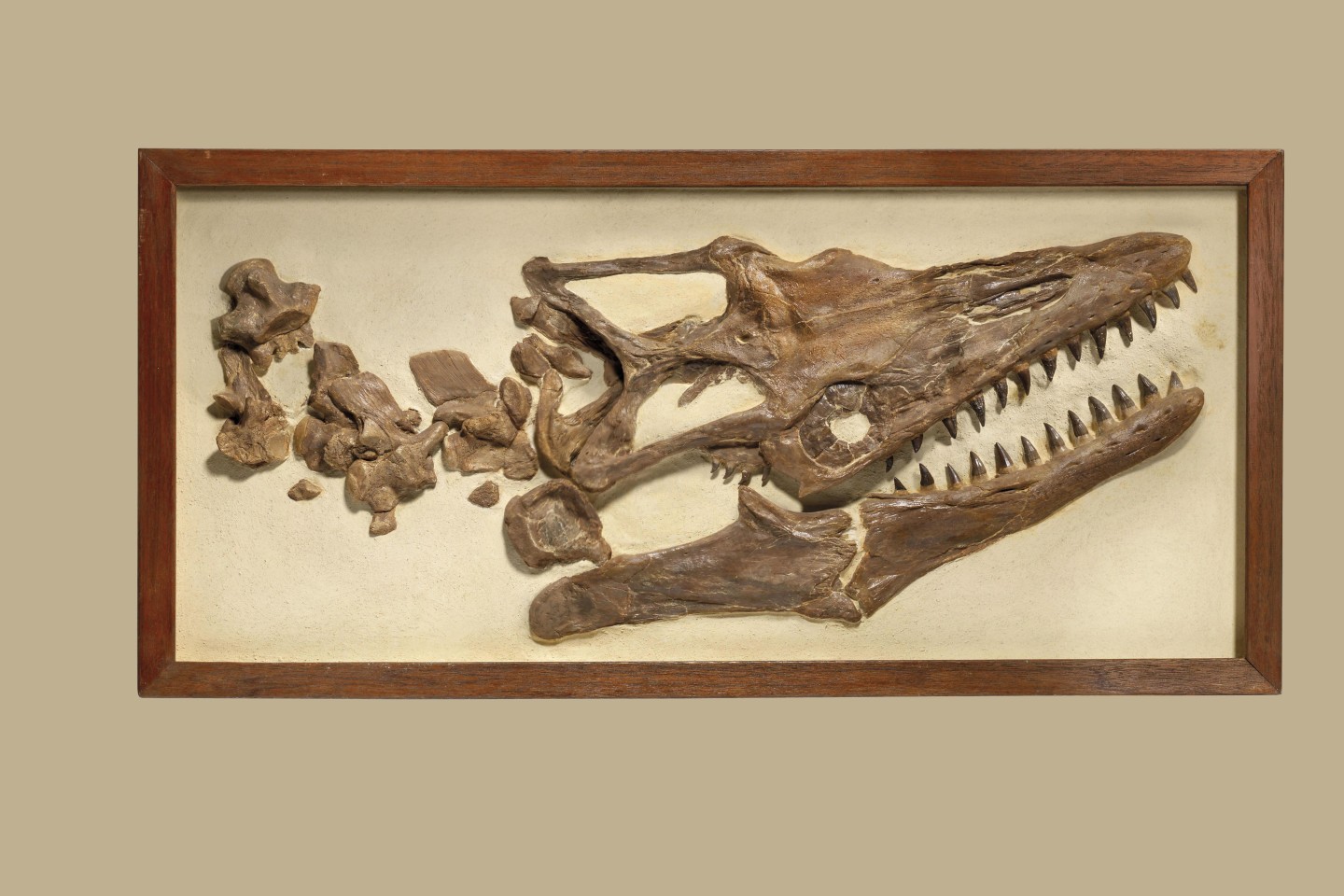
Christie’s
Christies Lot 121, May 21, 2020
Estimate: £7,000 – £10,000 (US$8,750 – US$12,500)
Another wall hanging is this framed mosasaur skull and neck vertabrae. It’s a tad smaller than the mosasaurs we saw during feeding time in the Jurassic World (2015) movie, but somewhat more realistically scaled too.
Mosasaur skulls can go as cheaply as $3000 for a research quality cast replica, through to $300,000 for a complete 7 meter skeleton.
Two uncoiled heteromorph ammonites
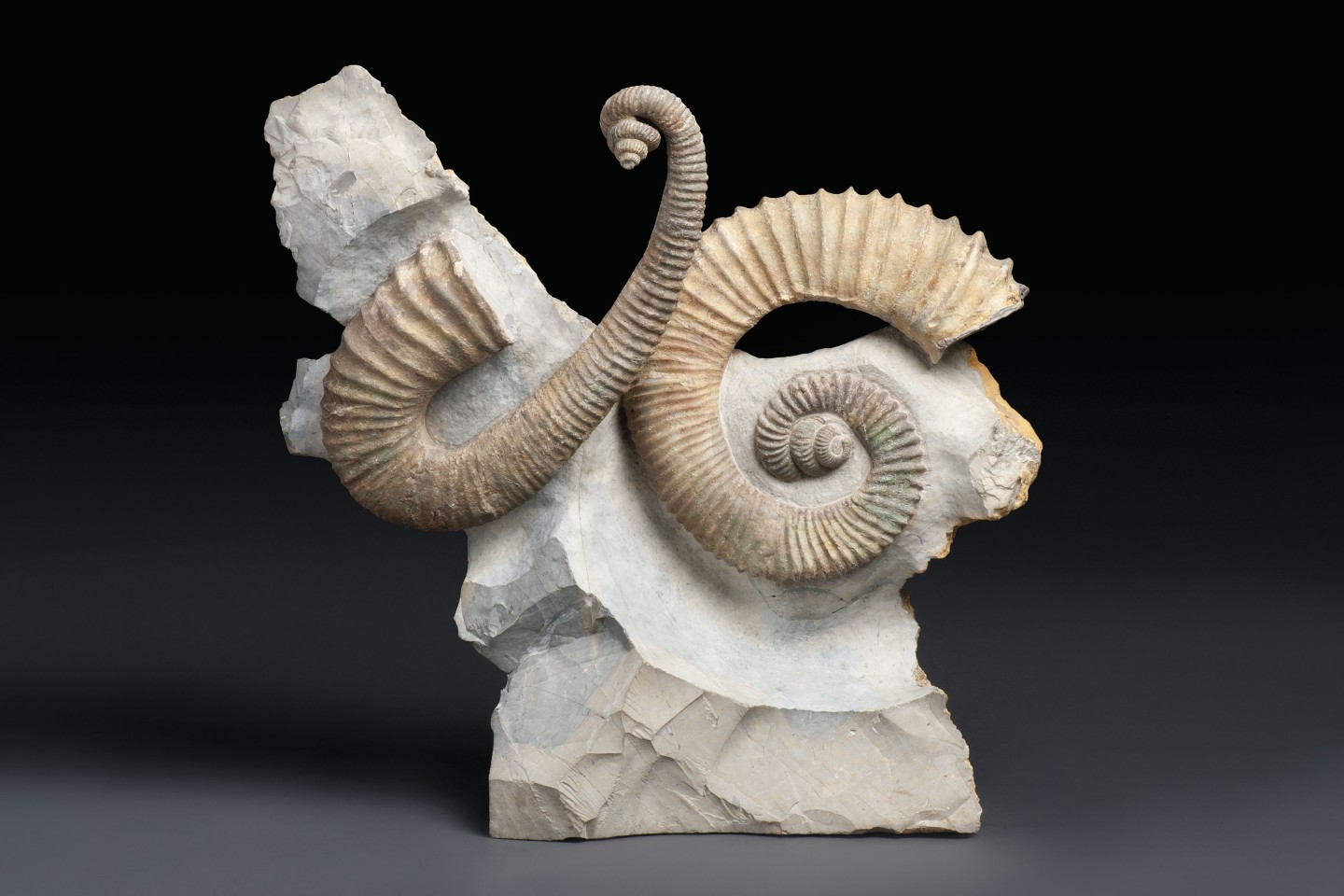
Christie’s
Christies Lot 11, May 21, 2020
Estimate: £10,000 – £15,000 (US12,500 – US$18,750)
One of the most distinctive of Cretaceous marine faunas, Ancyloceratina tend to have irregular shells that are not regular spirals and hence they make for interesting fossil decorations.
Souvenirs from Planet Earth’s most frightening predator
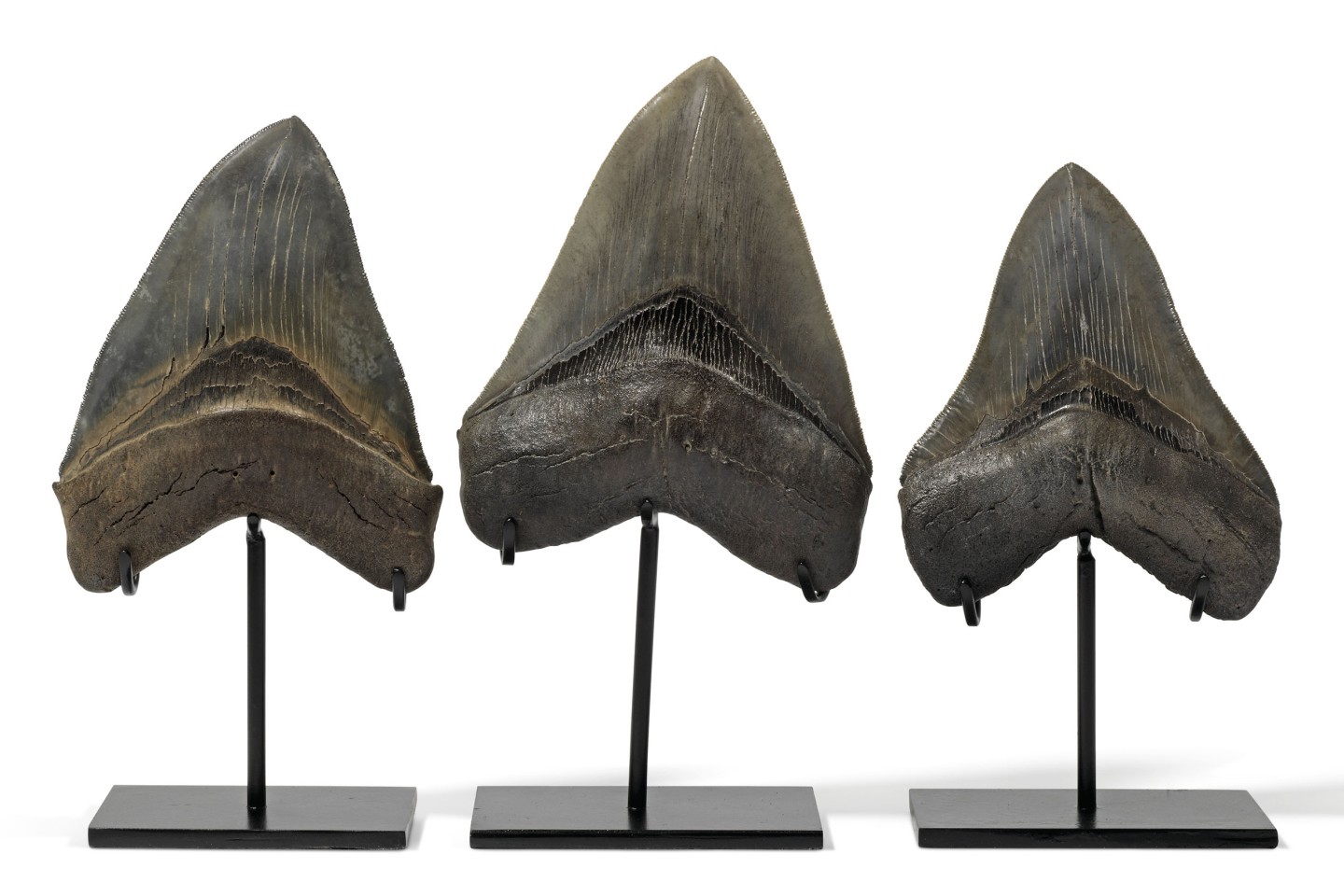
Christie’s
Christies Lot 50, May 21, 2020
Estimate: £5,000 – £8,000 (US$6,250 – US$10,000)
For millions of years, the apex predator of the oceans was a bus-sized shark known as the megalodon. A distant relative of the Great White Shark, there are enough stories about the megalodon’s size and lethality to turn a megalodon tooth into a wonderful conversation-starter. It’s also a great reminder that it isn’t the strongest that survive, but those most adaptable.
Perhaps the best point to start in framing the megalodon is its size. That’s a relatively small set of megalodon jaws below. Some of the larger ones that have gone to auction are big enough to swallow a Cadillac Escalade without it touching the sides. Scientists have calculated that a bite from a megalodon jaw could generate force of up to 40,000 pounds, which would give it the strongest bite in the entire animal kingdom.
Having something as frightening as a full-size megalodon jaw on the wall might not be exactly the type of ambience you’re seeking for your home, but a megalodon tooth might be worthwhile in the den, and there are quite a few megalodon teeth for sale at present apart from the above set of three, ranging in size and price: $1,875 to $3,125, $3,750 to $6,250 and another at $3,750 to $6,250.
The fifth largest piece of the Moon On Earth
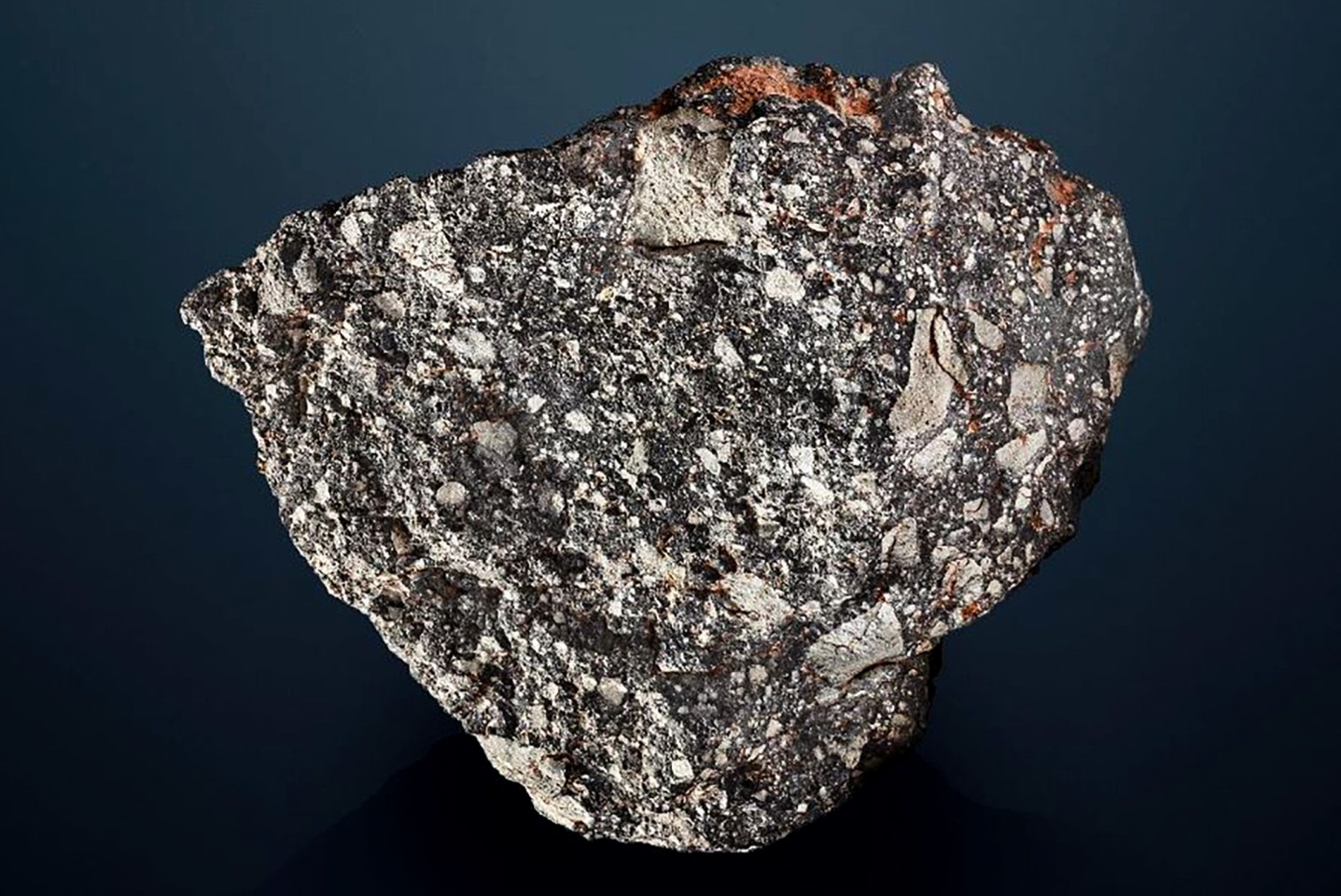
Christie’s
Christies Private Sales
Estimate: £2 million (USD$2.5 million)
Mankind went to a lot of trouble to obtain its first samples of moon rock, building rockets and spending vast sums in order to bring back relatively small quantities of the moon for scientific study – the Apollo program brought back around 382 kg.
They weren’t for sale though, and the only bits of the Moon available for private sale that came from the space race sold at auction at Sotheby’s in New York on November 29, 2018 for the hefty sum of US$855,000 – a few small shards that were so valuable they finished in fourth place on our annual listing of the most valuable scientific artefacts in 2018.
No sooner did mankind have its first known moon rocks, than it realized that we already had a supply of moon rock on earth. All those craters on the moon were formed by collisions with other space objects, many of which were so forceful that they ejected moon rock into space, most of which eventually succumbed to the earth’s gravity and arrived in the form of lunar meteorites. Since being first recognized as lumps of moon in 1982, there have now been over 370 lunar meteorites found, representing more than 30 separate meteorite falls.
It may sound like the supply of moon rock is now plentiful, but the total amount of the moon that is available to the private sector could fit inside two large suitcases and is in the vicinity of 250 kg. Hence moon rock is available, but it is one of the scarcest and most valuable commodities on earth. All that makes the above example quite special as it is the fifth-largest known piece of the moon on this planet.
This particular meteorite was part of a large meteorite shower straddling the Western Saharan, Algerian and Mauritanian borders, responsible for nearly half of all known lunar meteorites. Approximately 30 different meteorites were collected, analyzed, classified and assigned different NWA numbers in the belief they might be from different events and represent different lunar samples; but it has been determined that they all originate from the same lunar impact event as the current offering, NWA 12691, found in the Sahara Desert two years ago.
NWA 11616 Moon Rock with fusion crust
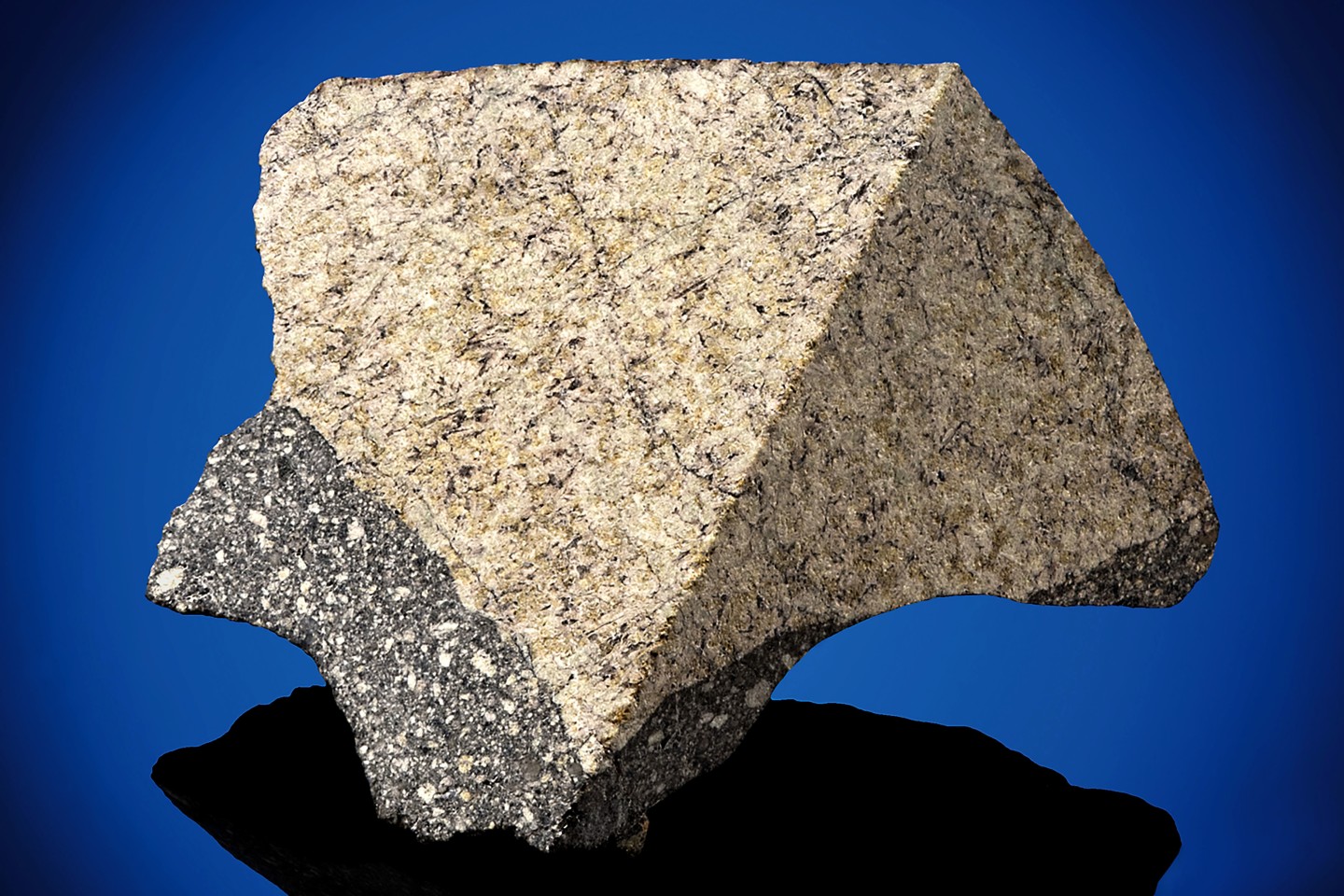
Christie’s
Christies Lot 12, May 21, 2020
Estimate: £7,000 – £10,000 (US$8,750 – US$12,500)
If buying moon rock in bulk such as the 13.5 kg NWA 12691 above is out of your price range, there are smaller samples available, and this 26.2 gram lump of NWA 11616 might fit the bill. Several previous segments cut from this lunar meteorite have been to auction, with a 45.7 gram sample selling for $12,500 in February 2019, and a 57.7 gram piece fetching $22,500 in February 2018.
Large amethyst geodes
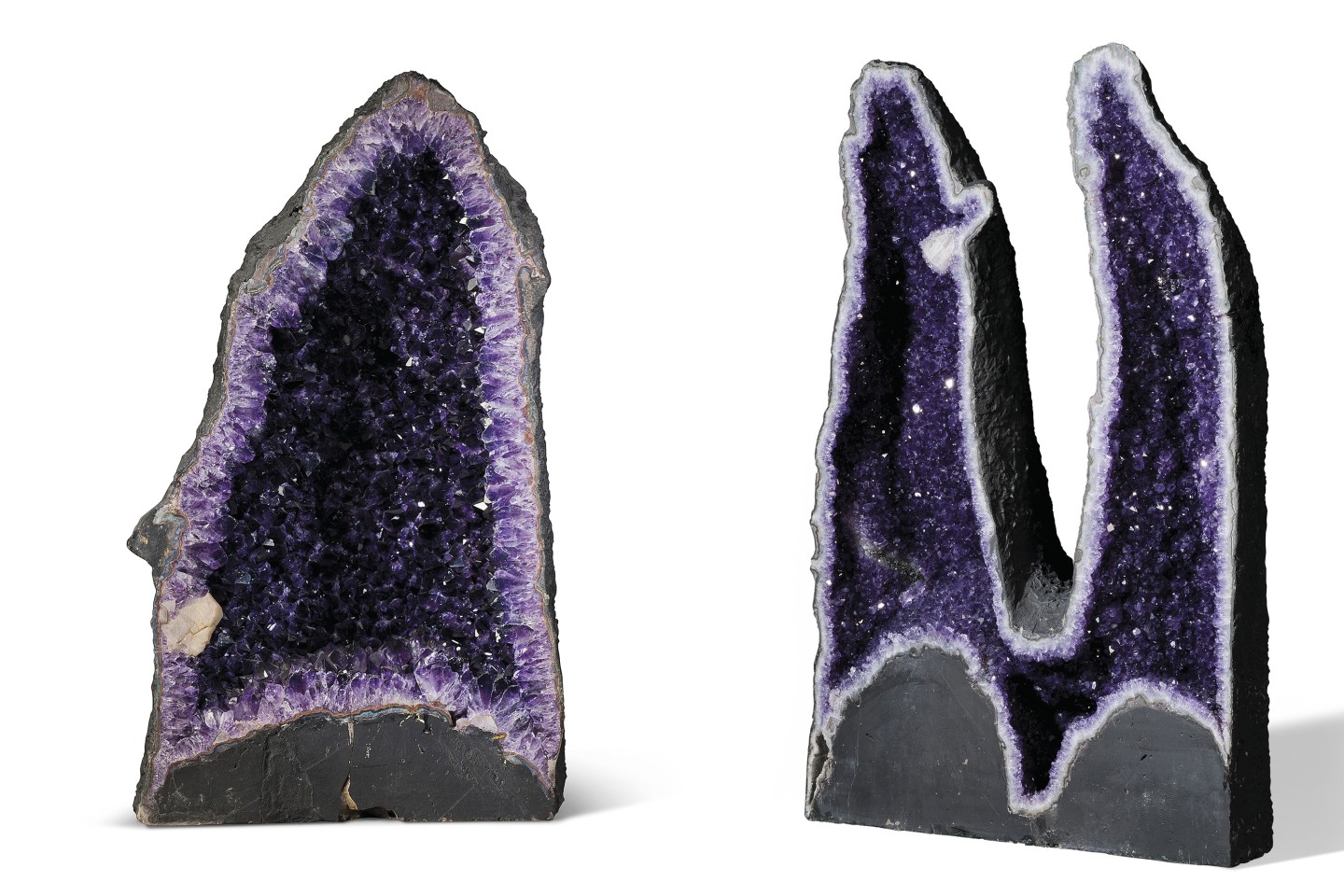
Christie’s
Christies Lot 96, May 21, 2020
Estimate: £4,000 – £6,000 (US$5,000 – US$7,500)
Only the largest and most beautiful amethyst geodes make it to auction, and the latest Christie’s on-line auction has three. The forked Geode at right in the above image has an estimate of £4,000 to £6,000 (US$5,000 – US$7,500), the geode at left in the image has an estimate of GBP£7,000 to £10,000 ($8,750 to $12,500) and a citrine geode not pictured has an estimate of £2,000 to £3,000 (US$2,500 to $3,750).
Large Triceratops Skull
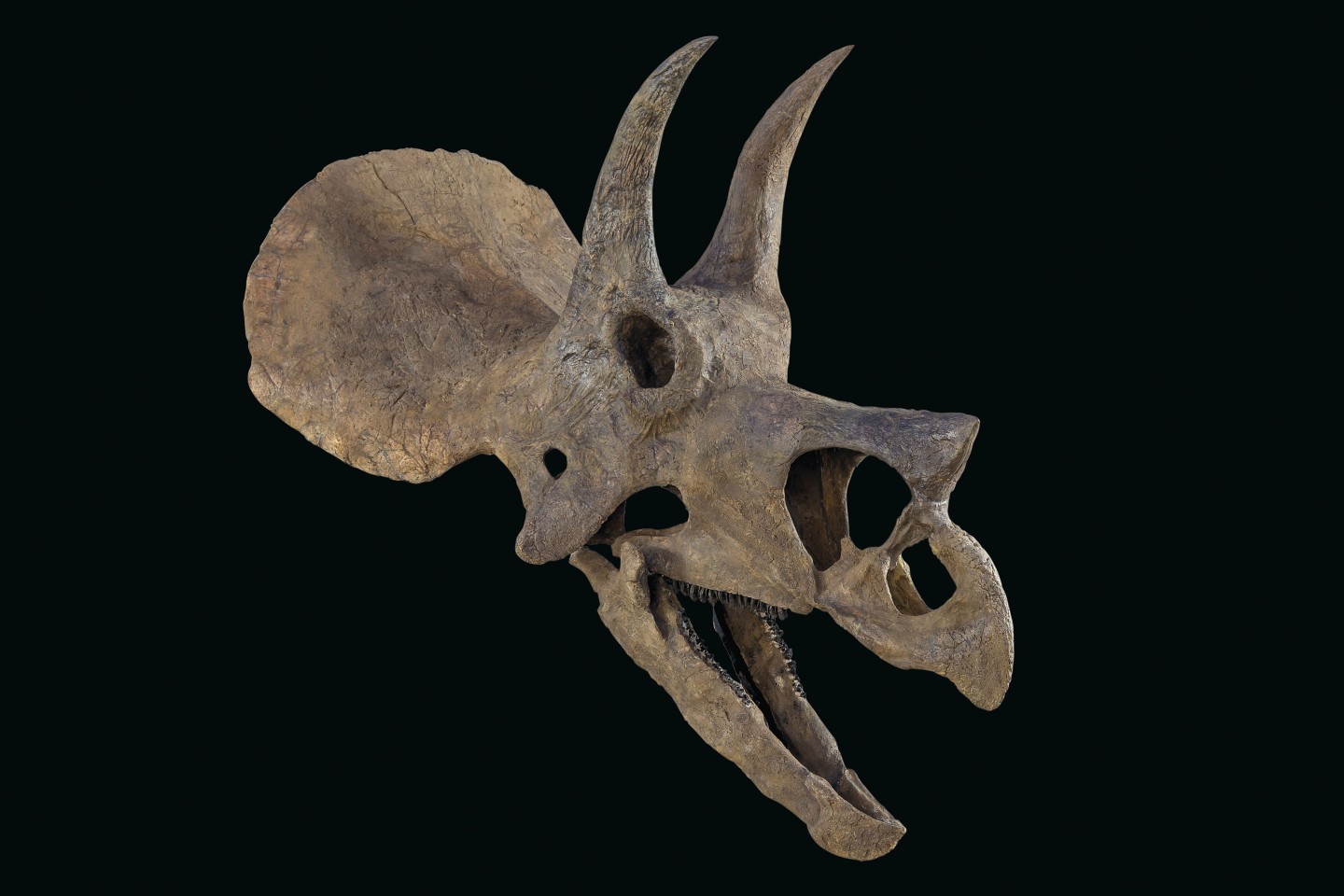
Christie’s
Christies Lot 44, May 21, 2020
Estimate: £150,000 – £250,000 (US$187,500 – US$312,500)
As one of the most distinctive and best known of dinosaurs, the skeletons of triceratops T. Horridus are highly sought-after when they come to market.
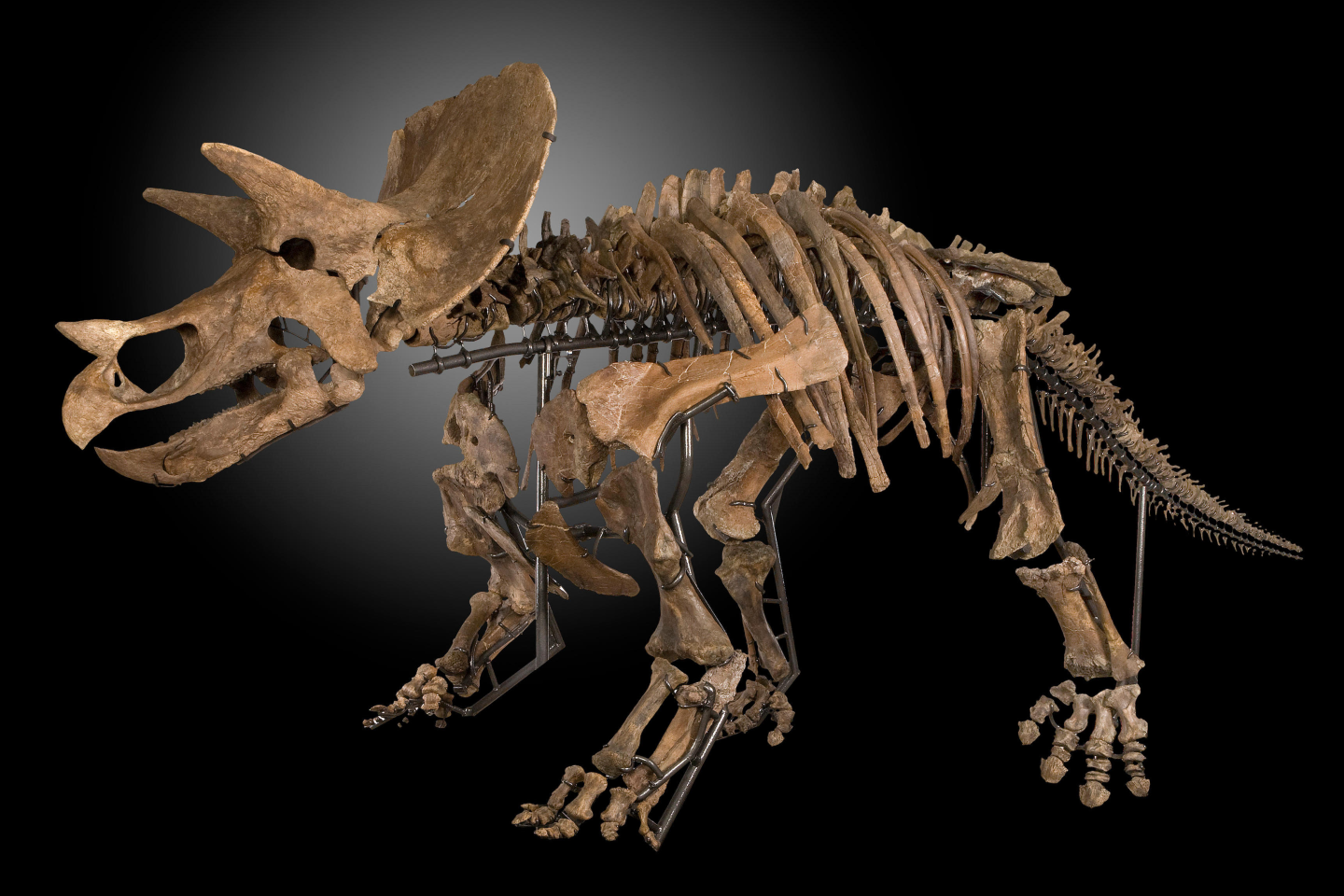
Bonhams
Several full skeletons have sold in recent years with the skeleton above expected to sell for between $700,000 and $900,000 in 2016 and failing to meet reserve. Another full skeleton fetched $440,000 at a Bonhams auction in 2009. The pictured skeleton is massive, being 26 ft long and ten feet tall, with a six foot long head with brow horns 24 inches long. When completed, it represented 65 percent original bone and 35 percent castings from the bones of other Triceratops.
While whole skeletons are ultra rare, skulls are less so, and a number have sold in recent time for US$242,000 on June 1, 2009, EUR177,800 (US$188106) on March 7, 2017, and GBP193,875 (US$302,317) on September 5, 2013, meaning that Christie’s estimate of $187,500 to $312,500 appears to be right in the zone.
12 inch Elephant Bird egg
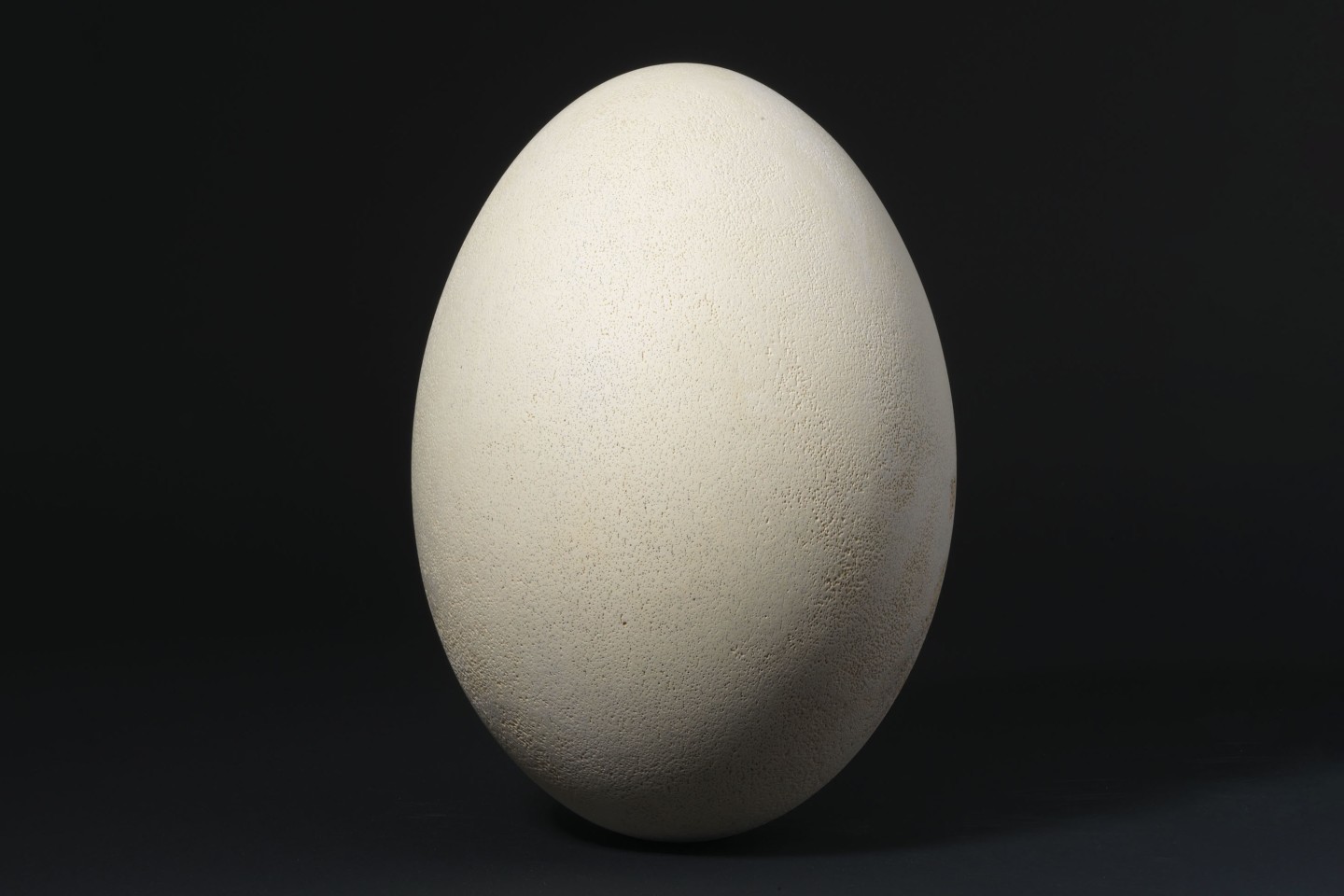
Christie’s
Christies Lot 41, May 21, 2020
Estimate: £30,000 – £50,000 (US$37,500 – US$62,500)
The elephant bird is believed to have been the largest bird to have ever lived, though recent finds suggest that very large birds may have been more plentiful than we thought. The flightless Aepyornis maximus was native to Madagascar and stood over 10 feet tall (3 m), having died out as a species approximately 400-500 years ago. The elephant bird laid the largest eggs of any vertebrate, living or dead, and even larger than any dinosaur.
Indeed, the size of these eggs may have contributed to their demise, as they were driven to extinction by a combination of climate change, shifts in vegetation patterns and humans’ pillaging of their eggs which are roughly equal to 150 chicken eggs in volume.
Hence it’s not surprising that elephant bird eggs make such awesome exhibit pieces and command such high prices. If the $37,500 to $62,500 estimate seems high, bear in mind that with the species having been extinct for a few centuries, and as the birds were native to Madagascar, where law now mandates that new finds are the property of the Malagasy government, supply is now fixed.
Hence elephant bird eggs now routinely fetch more than $100,000, and the record price for an elephant bird egg is now GBP122,500 (US$205,547) set at a Christie’s sale in London in 2014. That price was achieved by an egg almost identical in size to the egg on offer here.
Large petrified wood triassic table
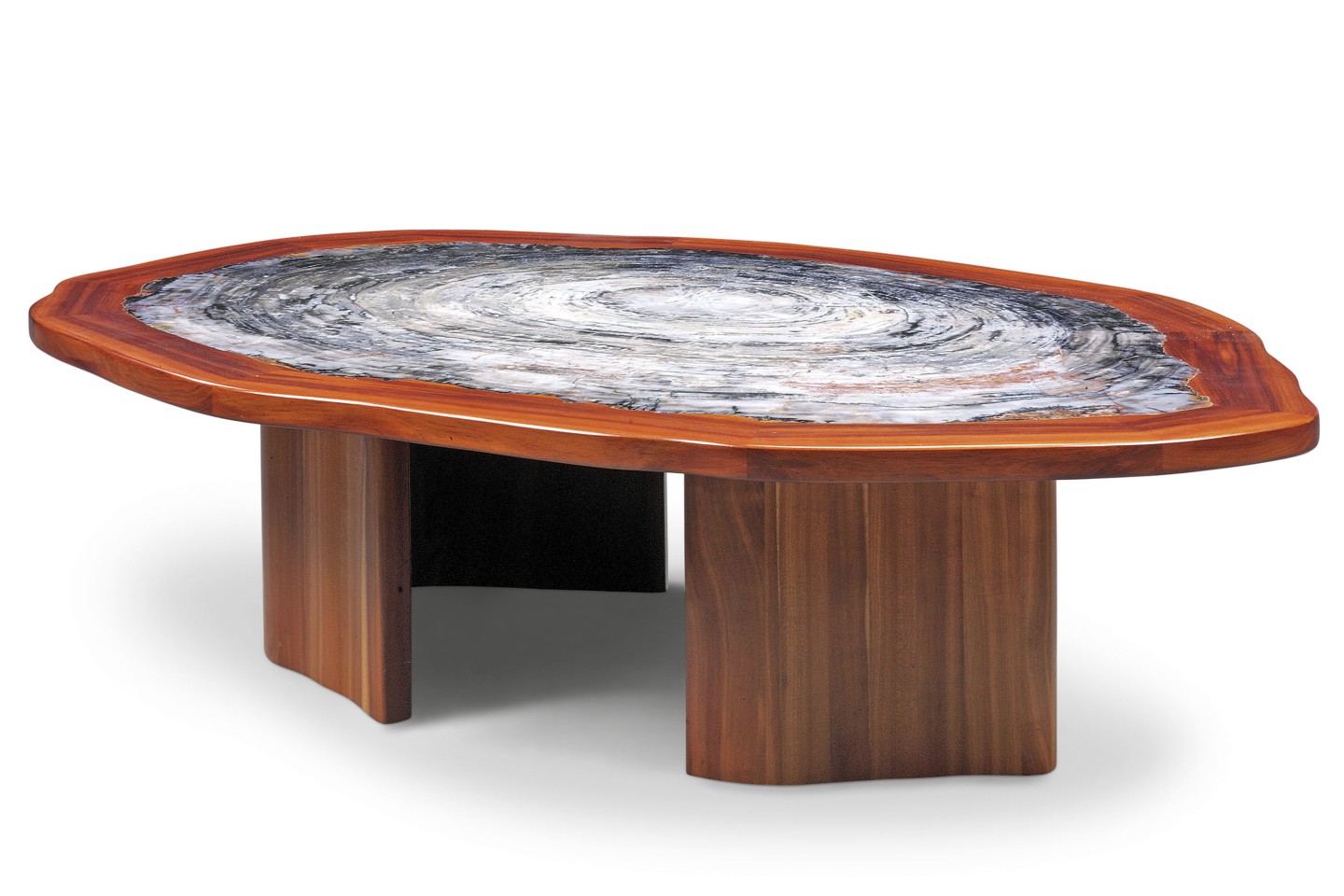
Christie’s
Christies Lot 83, May 21, 2020
Estimate: £10,000 – £15,000 (US12,500 – US$18,750)
Considering the beauty the surface of this table, the anticipated price range seems a bargain.
Rare heteromorph ammonite
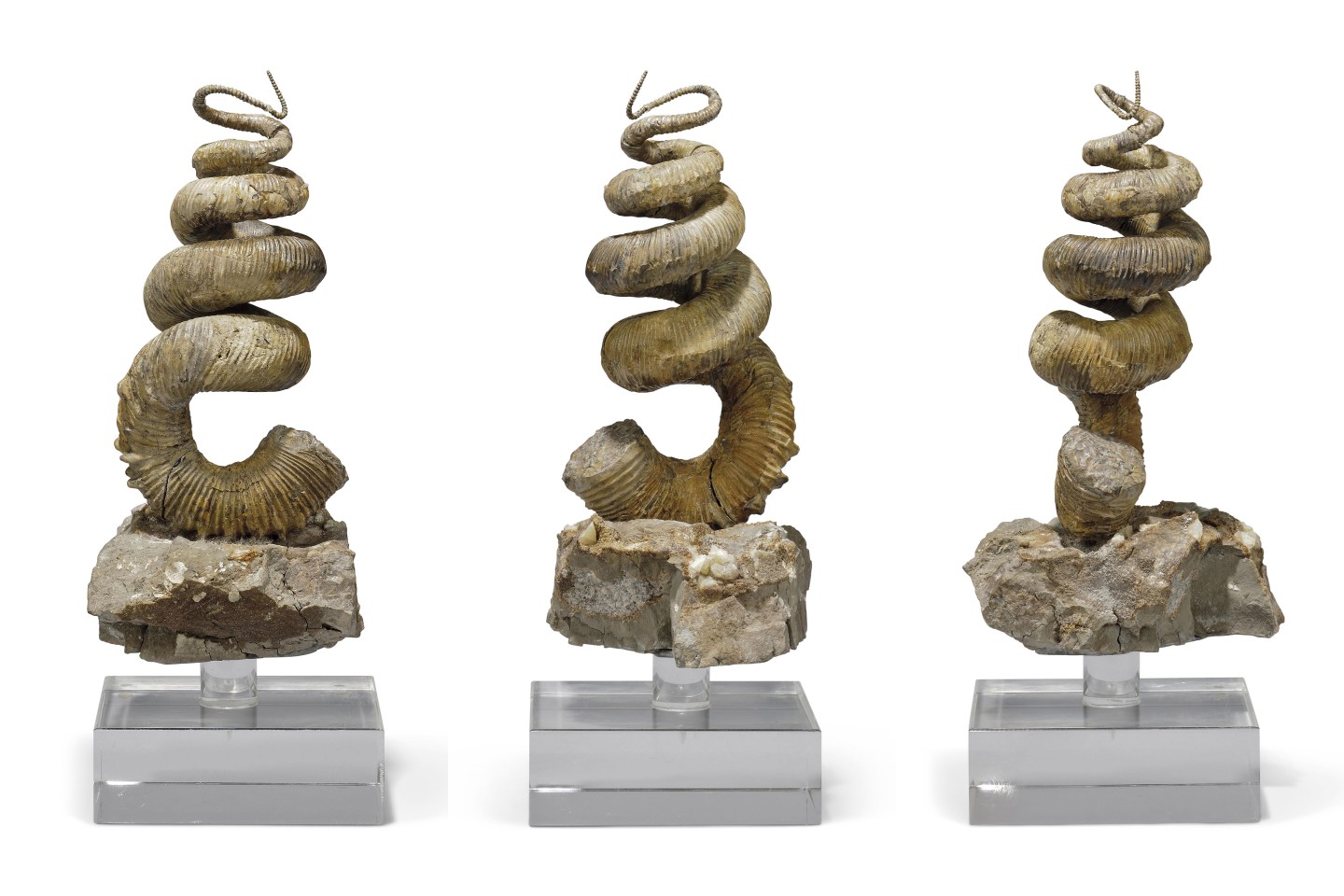
Christie’s
Christies Lot 2, May 21, 2020
Estimate: £3,000 – £5,000 (US$3,750 – US$6,250)
The above shows three views of the same Didymoceras cheyennens. A specimen from the Upper Campanian Cretaceous (circa 72 million years ago) period, this poor creature’s shell would no doubt have been a serious impediment to swimming, but given its size, the specimen obviously lived a long and healthy life.
Scientifically Important Meteorite
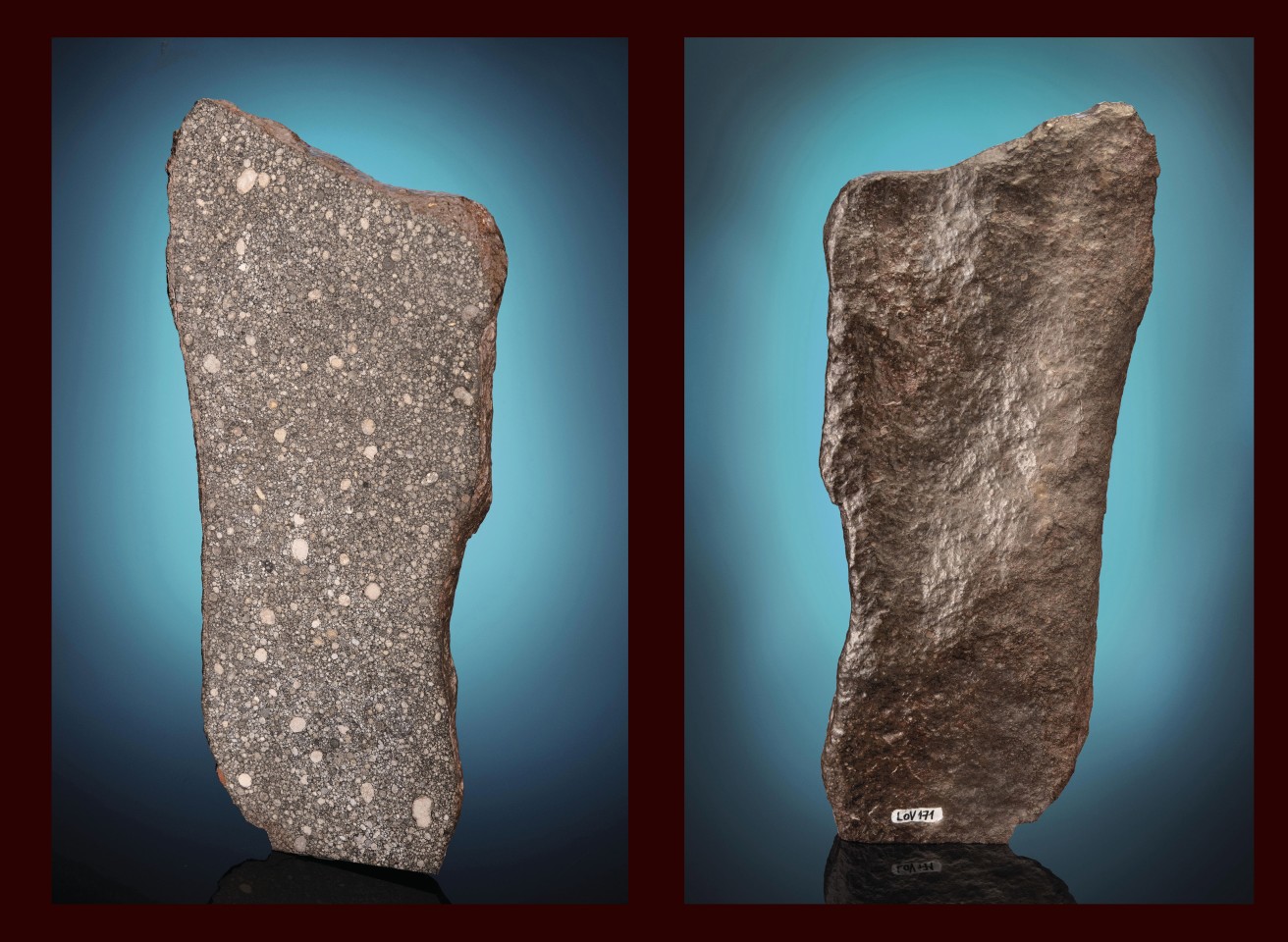
Christie’s
Christies Lot 54, May 21, 2020
Estimate: £5,000 – £7,000 (US$6,250 – US$8,750)
Recovered in the Atacoma Desert in Chile (the highest desert on Earth), this is a special type of meteorite, as its constituents are almost unchanged since their origins in the early solar nebula when it first precipitated out of the cloud from which our solar system formed. It escaped the heating that results from pressure and radiation and it retained its primitive texture and composition. Prior to the discovery of Los Vientos 171, less than 40 kg of similarly primitive planetary material was known to exist. Devoutly sought-after by scientists, such unmetamorphosed, primitive meteorites reveal the raw ingredients of the planets.
Small Sikhote Alin meteorite
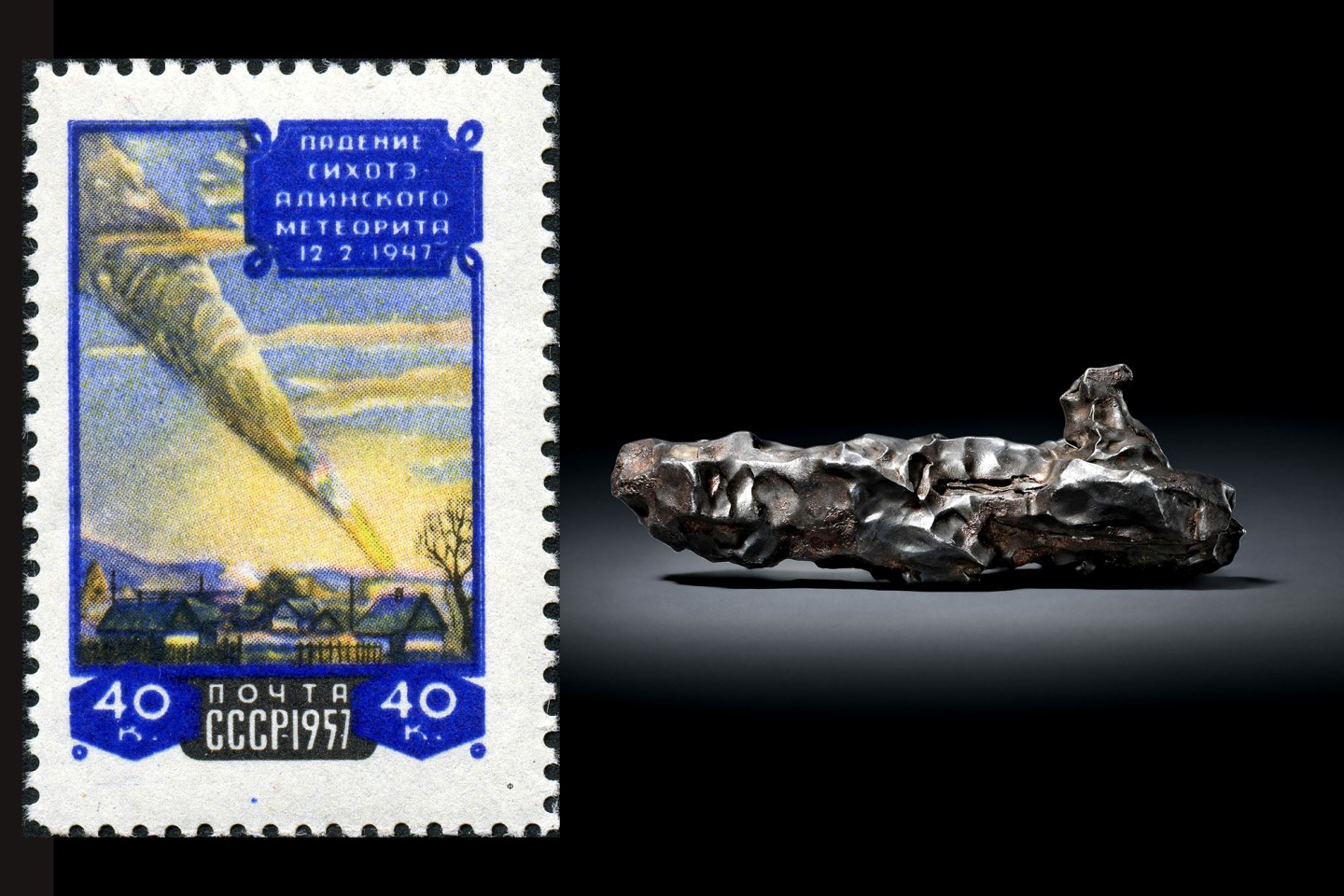
Christie’s
Christies Lot 30, May 21, 2020
Estimate: £1,500 – £2,500 (US1,875 – US$3,125)
This little lump of iron made quite an entrance when it descended to Earth on February 12, 1947. It and its brethren pieces from the parent Sikhote-Alin meteorite created a fireball that was so bright, it created moving shadows in broad daylight (i.e. it was brighter than the Sun). The asteroid exploded at an altitude of about 6 km over eastern Siberia, creating sonic booms that were heard 300 km away. Chimneys collapsed, windows shattered and trees were uprooted. In 1957 the Soviet Union issued a stamp for the 10th anniversary of the Sikhote-Alin meteorite shower. The stamp features a painting by P. I. Medvedev, a Soviet artist who was sitting in his window starting a sketch when the fireball appeared, so he immediately began drawing what he saw.
Large Watermelon Tourmaline Bowl
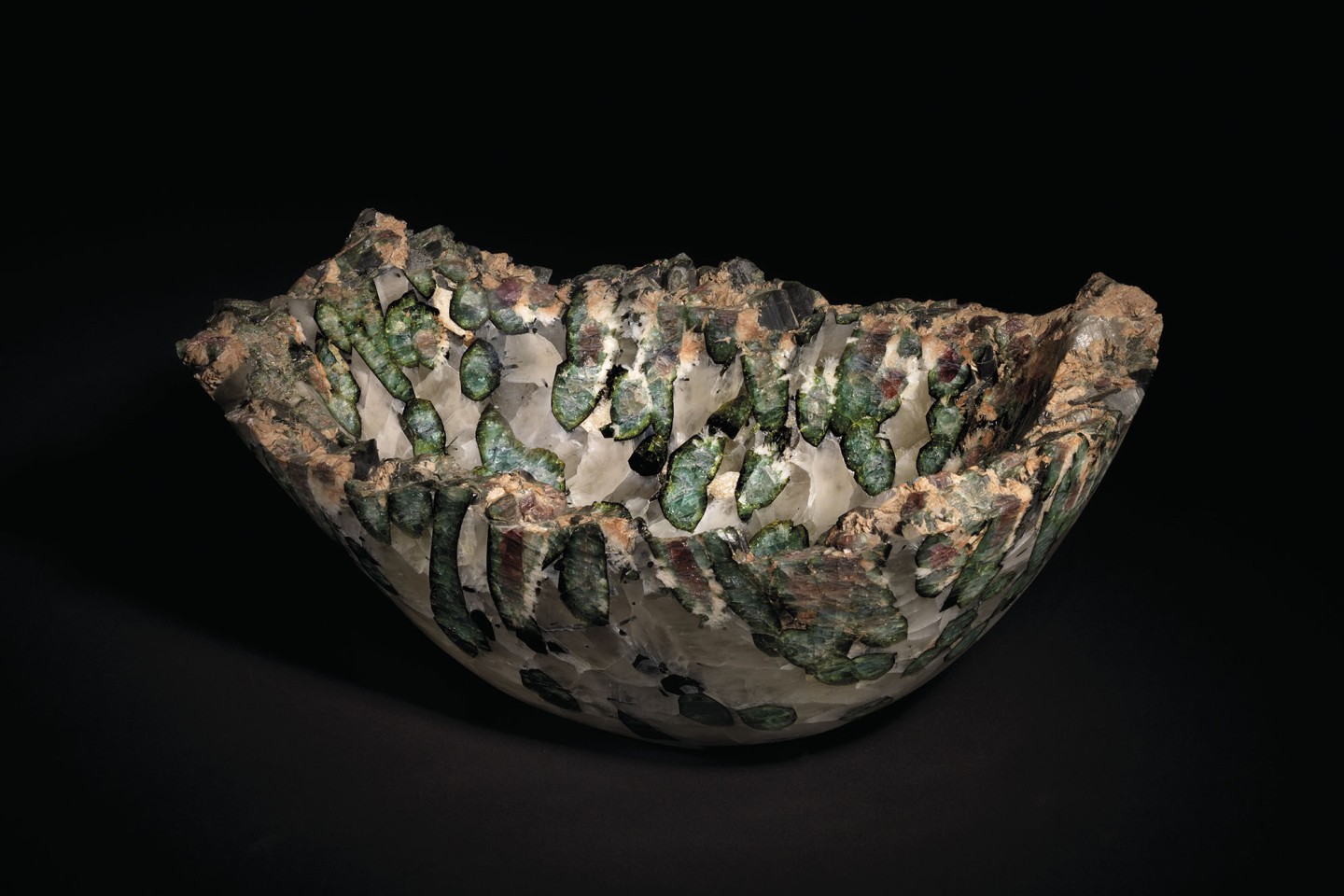
Christie’s
Christies Lot 52, May 21, 2020
Estimate: GBP£18,000 – GBP£25,000 (US22,500 – US$31,250)
Tourmaline is one of the brightest and most versatile of all semi-precious gemstones, occurring in almost every color and often in specimens of considerable size. This extra large example with giant watermelon-colored crystals set in a purple, white and pink quartz matrix has been made into a large 15-inch-long bowl, with its heritage emphasized by the rim of the bowl being left in its natural state.
Muonionalusta meteorite pen and dice with diamonds
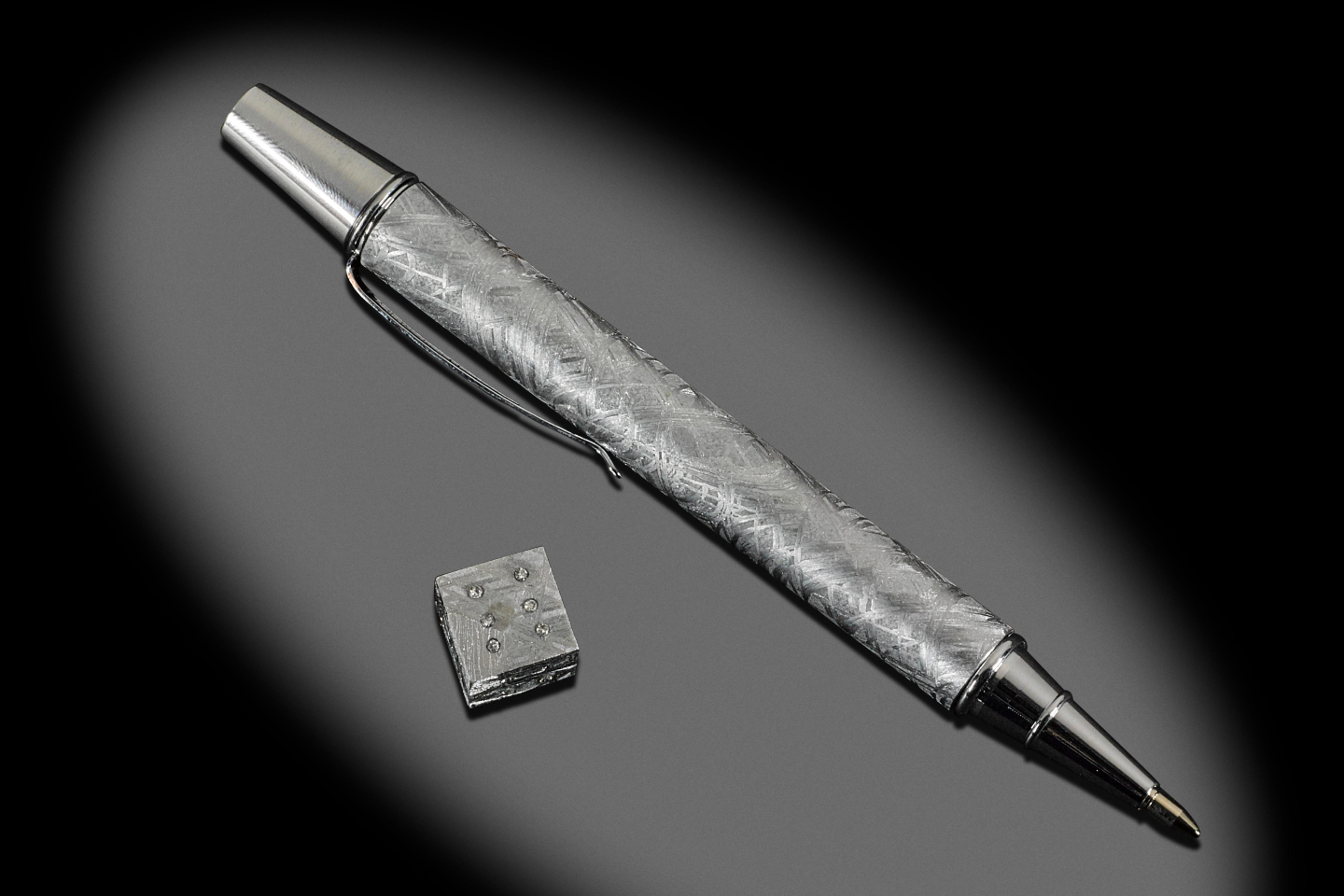
Bonhams
Bonhams, May 21, 2020
US$1,800 – US$2,500 (US$2,250 – US$3,125)
The Muonionalusta is a meteorite which impacted in northern Scandinavia about one million years BCE, coming from a parent body that was one of the earliest to take shape during the formation of our solar system. The importance of the Muonionalusta and how it got its distinctive Widmanstätten Pattern are wonderfully explained at Mad Scientist.
Someone, somewhere, along the way, decided to take a piece of Muonionalusta and turn it into the barrel of a pen, which we think is one of the coolest pens around, particularly if you are one of those people absolutely obsessed with the wonders of natural science.
The pen is offered together with a dice which is also made of Muonionalusta meteorite with pips inset with diamonds, measuring 1.2 cm. If you are sufficiently into how the space crystallization patterns formed, you’ll understand the significance of the dice and may bid on it. We don’t think this will sell within its suggested range, but good luck.
Extraterrestrial zoomorphic tabletop sculpture
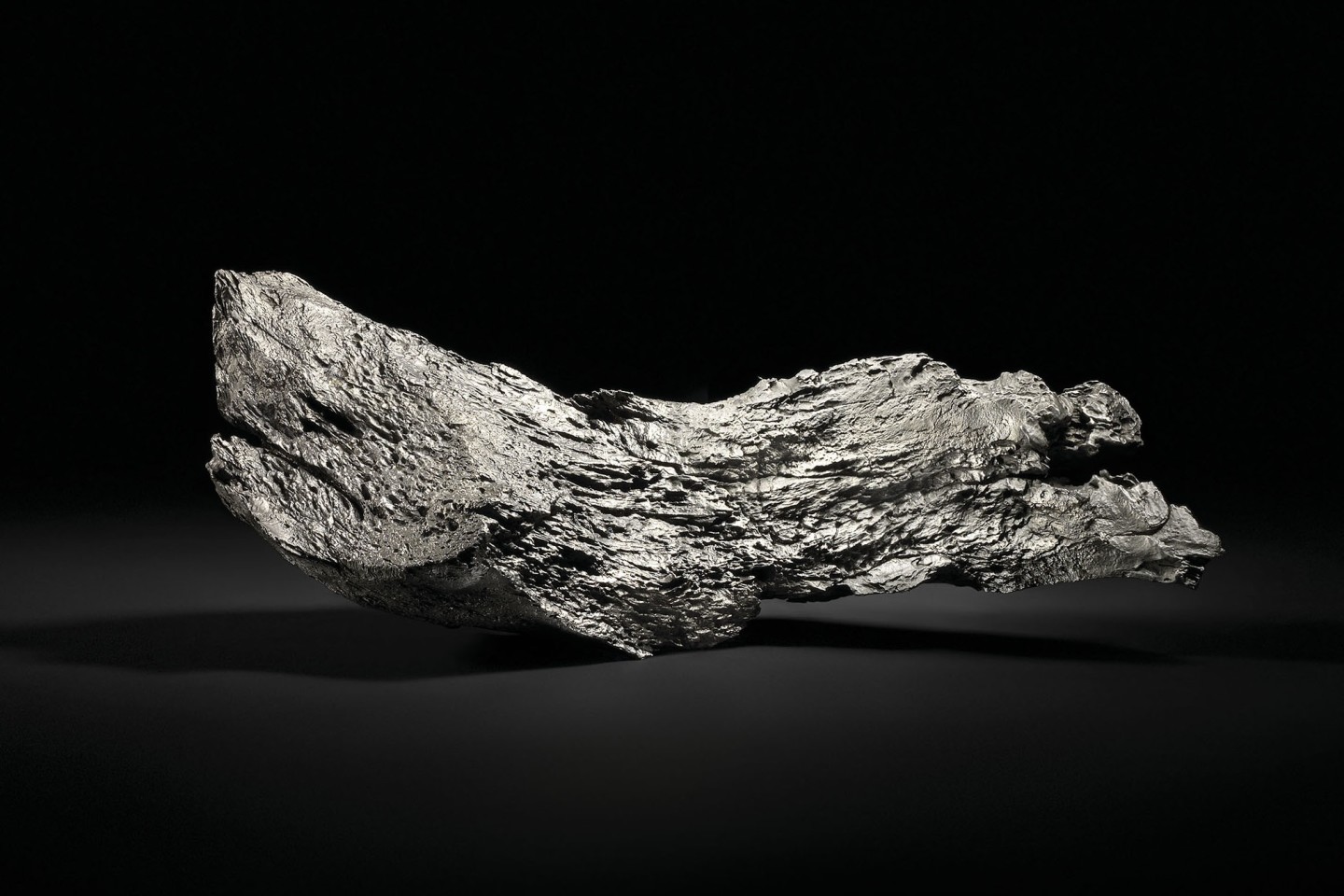
Christie’s
Christies Lot 24, May 21, 2020
Estimate: £15,000 – £25,000 (US$18,750 – US$31,250)
The Dronino meteorite was found in 2000 and identified as meteoritic in 2003. Despite this recent recognition, no historical records exist of a meteorite fall in the area of Russia in which it is found, and hence it is believed that the meteorite fell before the earliest human settlements in the region in the 12th century. Classified as an Ataxite, the distressed patina of the Dronino meteorite fragments are the result of terrestrial sculpting and sulfide inclusions within the meteorites. To date, around 600 fragments of the Dronino meteorite have been found with a total mass of about 3,000 kilograms, over an area 500 meters wide and 1.5 kilometers long.
Fine specimen of malachite
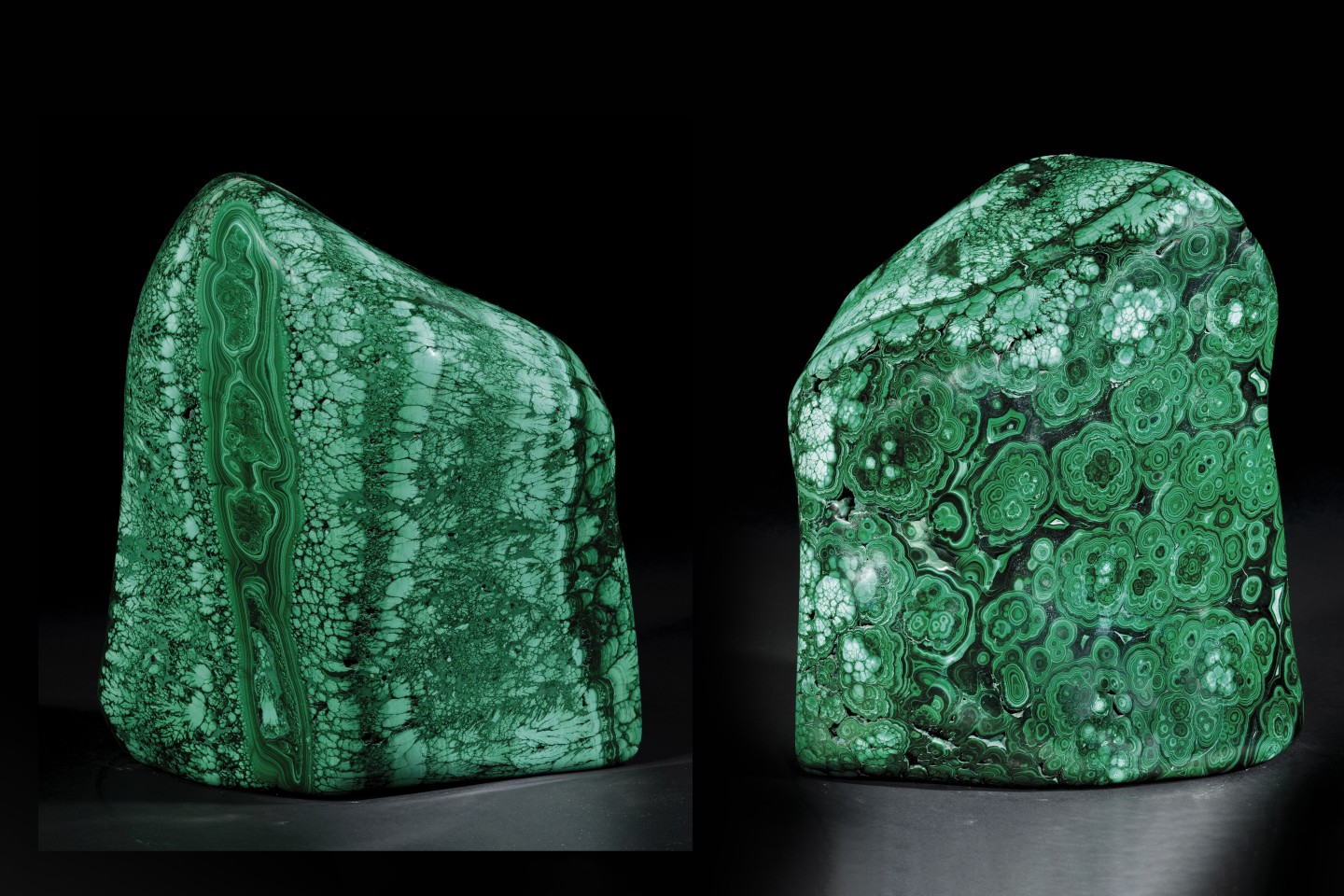
Christie’s
Christies Lot 97, May 21, 2020
Estimate: £2,000 – £3,000 (US$2,500 – US$3,750)
Malachite has been mined on an industrial scale for at least 4000 years, primarily as a source of copper: the first metal to be smelted from sulfide ores, c. 5000 BC; the first metal to be cast into a shape in a mold, c. 4000 BC; and the first metal to be purposefully alloyed with another metal, tin, to create bronze, c. 3500 BC. Once mankind found a more viable way of producing copper, malachite returned to being the primary mineral pigment in green paints and in more recent times, simply an ornamental stone. The natural beauty of malachite has never been lost, however, with the Ancient Egyptians referring to the eternal paradise of the afterlife as a “Field of Malachite.”
Large Triceratops horn
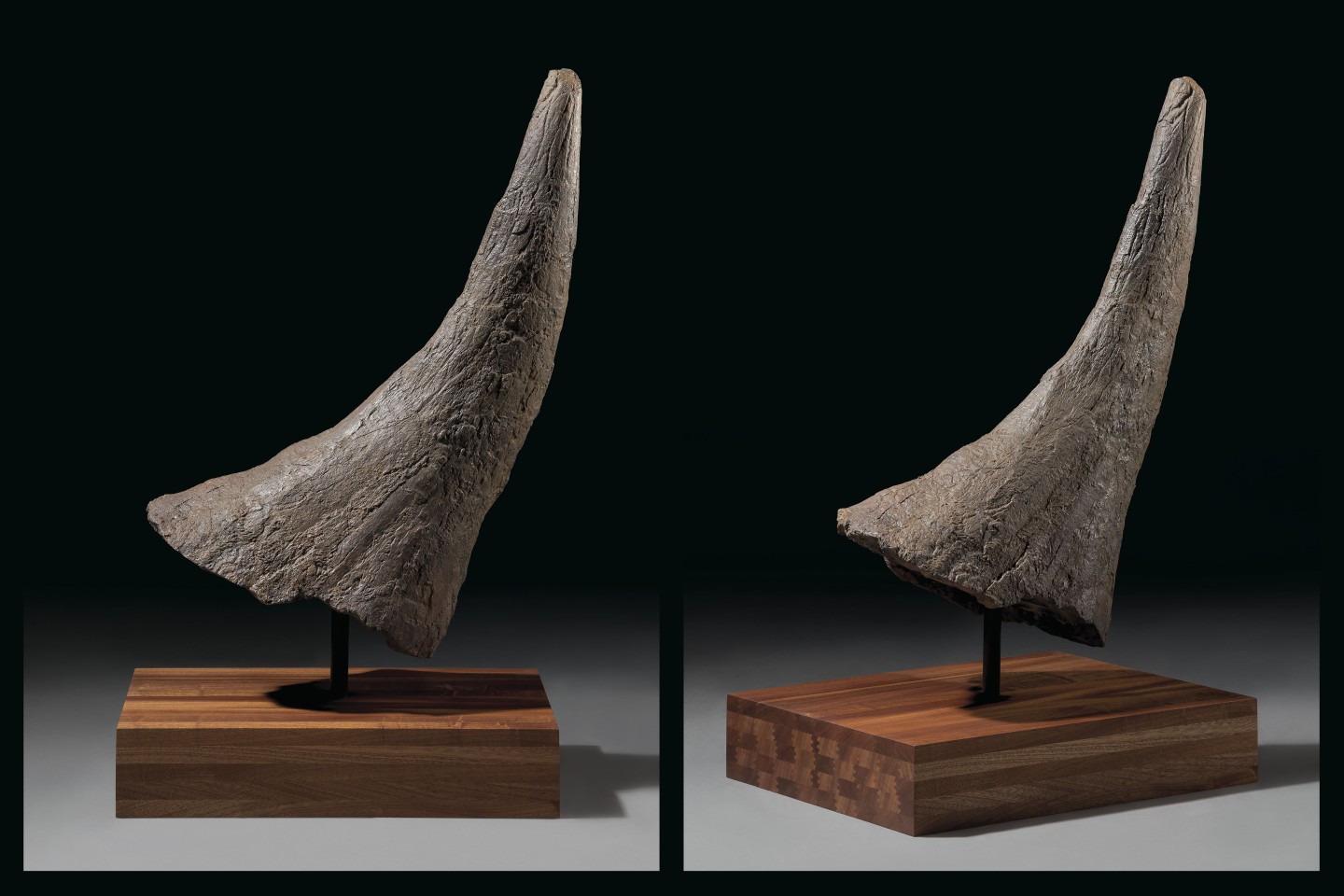
Christie’s
Christies Lot 68, May 21, 2020
Estimate: £15,000 – £25,000 (US$18,750 – US$31,250)
Compared to entire Triceratops skeletons (which are almost as rare as the unicorns that they were once believed to be), and Triceratops skulls, Triceratops horns are relatively plentiful and sell regularly for between US$10,000 and $30,000 with size being the greatest differentiator. The most we’ve ever seen one sell for at auction was a whopping 47½ inches (121 cm) long horn that fetched GBP£35,000 (US$46,442).
Superb Semychan Meteorite pallasitic sphere
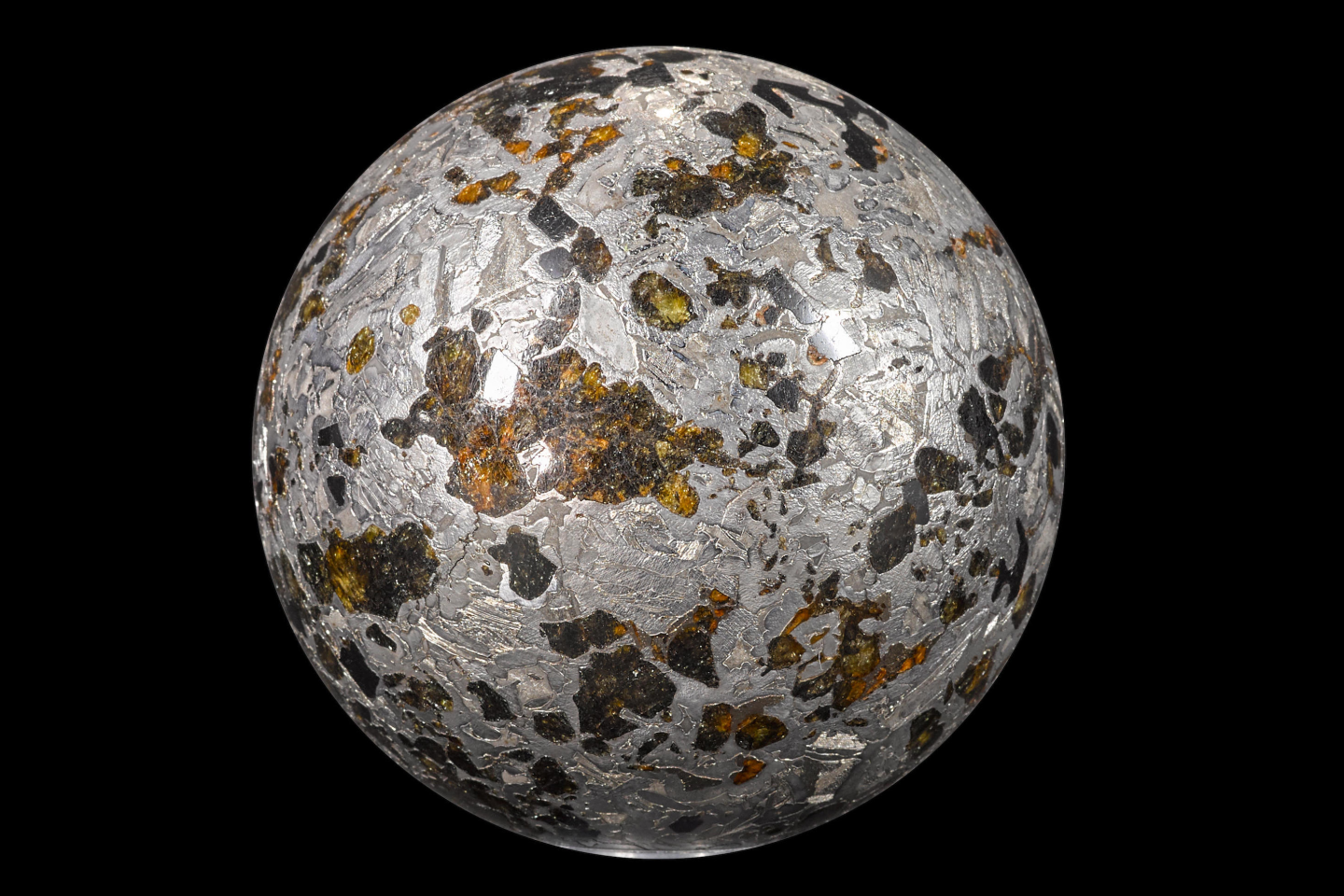
Bonhams
Bonhams, Lot 64, May 21, 2020
Estimate: £25,000 – £30,000 (US$31,250 – US$37,500)
The Seymchan meteorite is a Main Group pallasite, but it is considered anomalous due to its high Iridium content. A second expedition to the remote strewnfield in 2004 yielded an additional 50 kg of the meteorite with approximately 20 percent of the new specimens found to contain olivine crystals. This evidenced its origin near the core/mantle boundary of what is believed to be an asteroid which was destroyed during the formation of our solar system, approximately 5.5 to 6 billion years ago. This 10 cm diameter sphere was carved from one of those 2004 specimens and is quite gorgeous with its contrast of etched and polished surfaces which reveal the Widmanstätten pattern of crystallization.
Labradorite from Madagascar
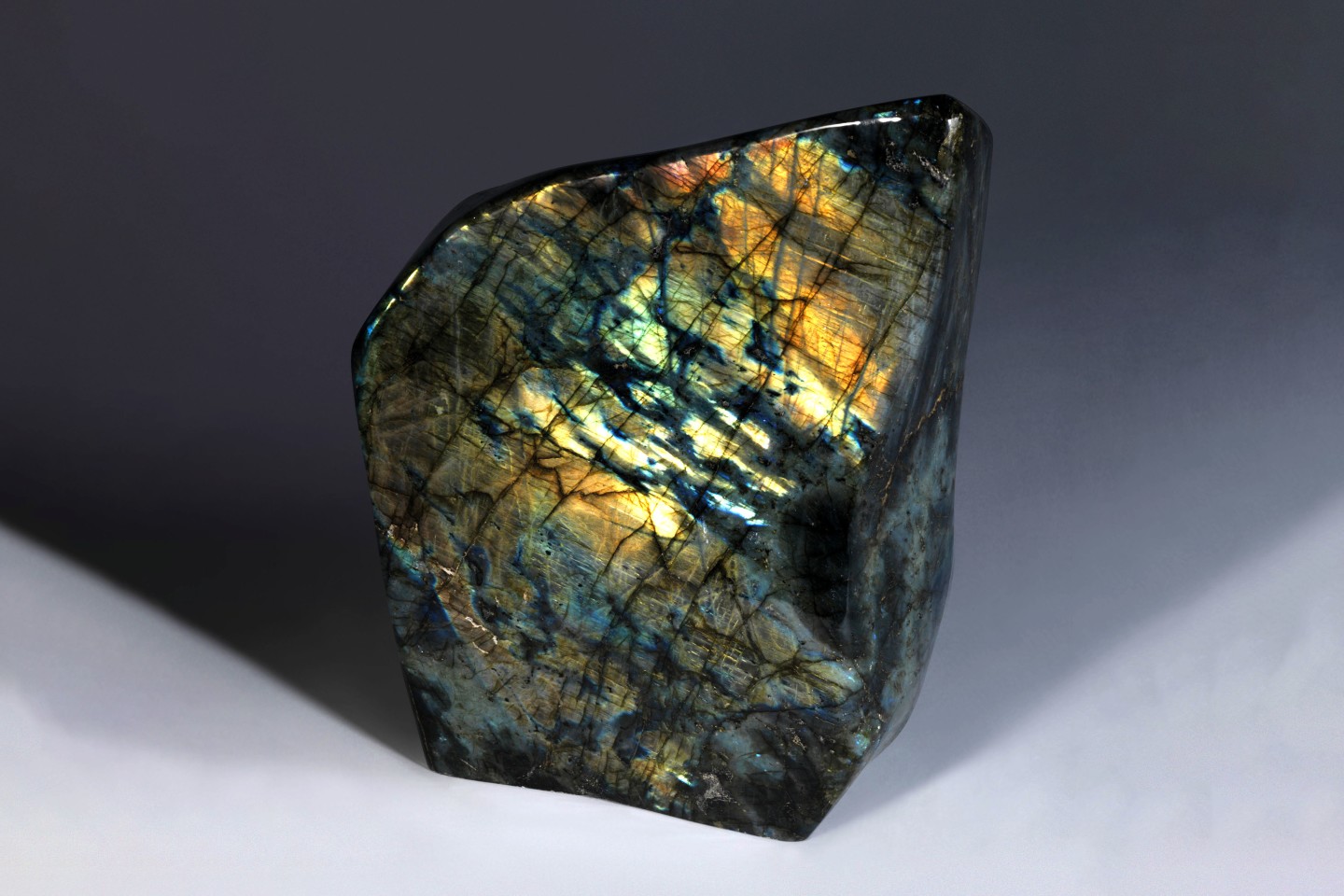
Christie’s
Christies Lot 63, May 21, 2020
Estimate: £800 – £1,200 (US$1000 – US$1500)
No-one does materials science quite like Mother Nature, and one of her finest is Labradorite. Thanks to a unique internal structure, the stone displays an iridescent optical phenomenon known as labradorescence, an ethereal shimmering of an array of colors that vary with each stone. Still images cannot do the stone justice.
Large Citrine Sphere
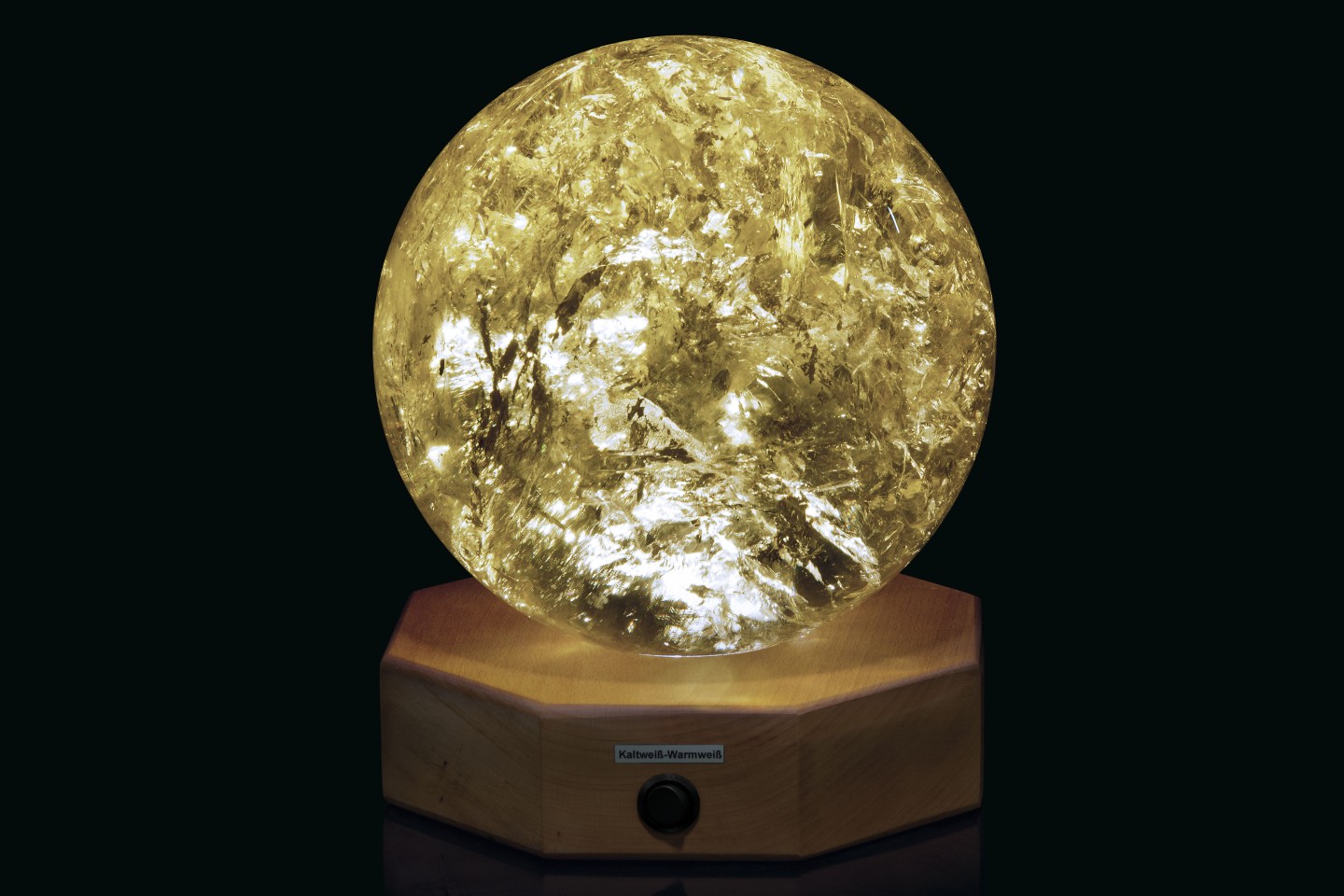
Christie’s
Christies Lot 81, May 21, 2020
£8,000 – £12,000 (US$10,000 – US$15,000)
Citrine is a transparent, yellow variety of Quartz that was first appreciated as a golden-yellow gemstone in Greece between 300 and 150 BC, during the Hellenistic Age. This large sphere of Citrine is lit from below to enhance its natural beauty.
Seymchan meteorite cube
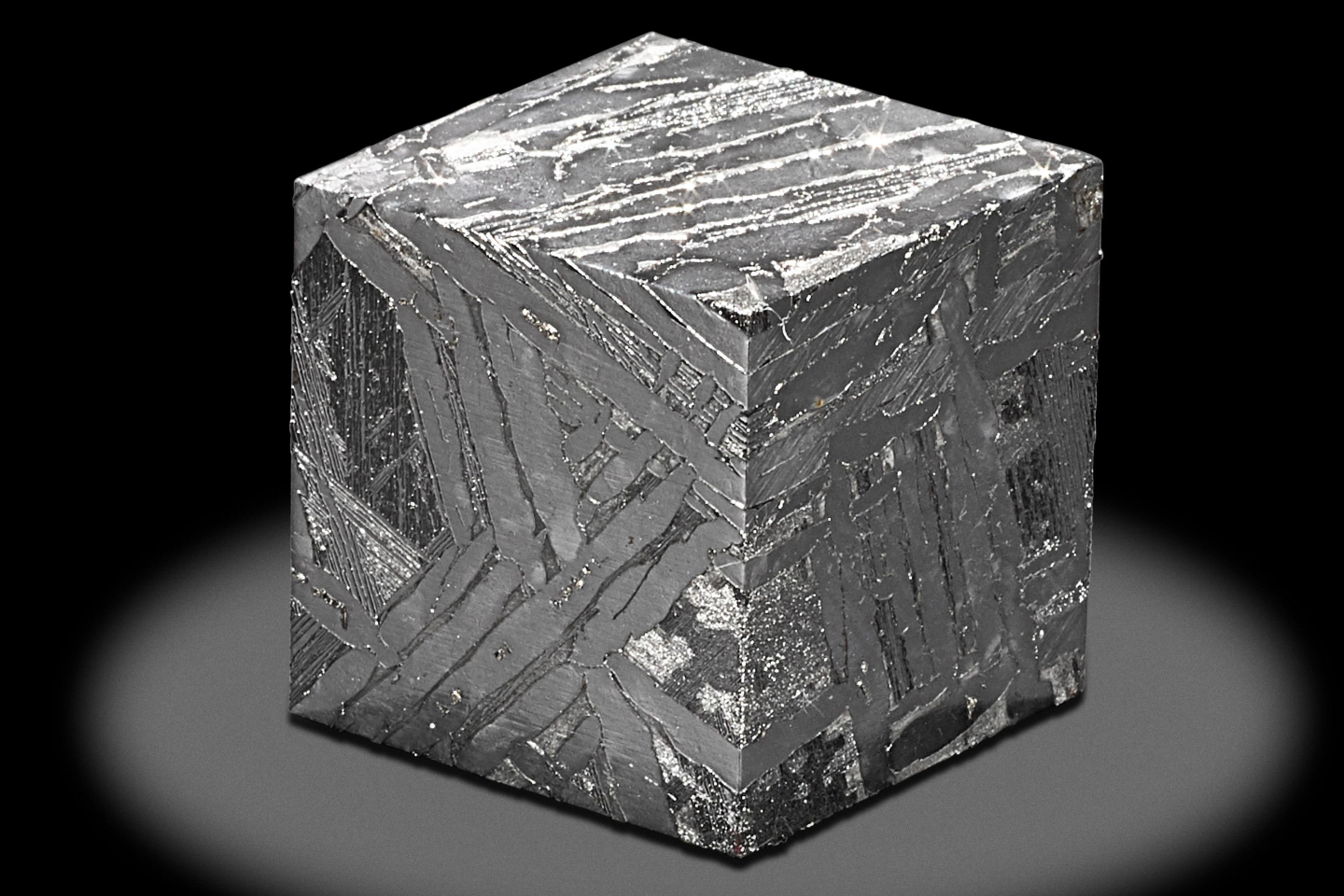
Bonhams
Bonhams, May 21, 2020
£2,200 – £2,800 (US$2,750 – US$3,500)
Deriving from the same Seymchan asteroid mentioned above, though with vastly different visual characteristics, this cube has been acid-etched to reveal the Widmanstätten pattern of crystalization on the surface.
23cm rose quartz sphere
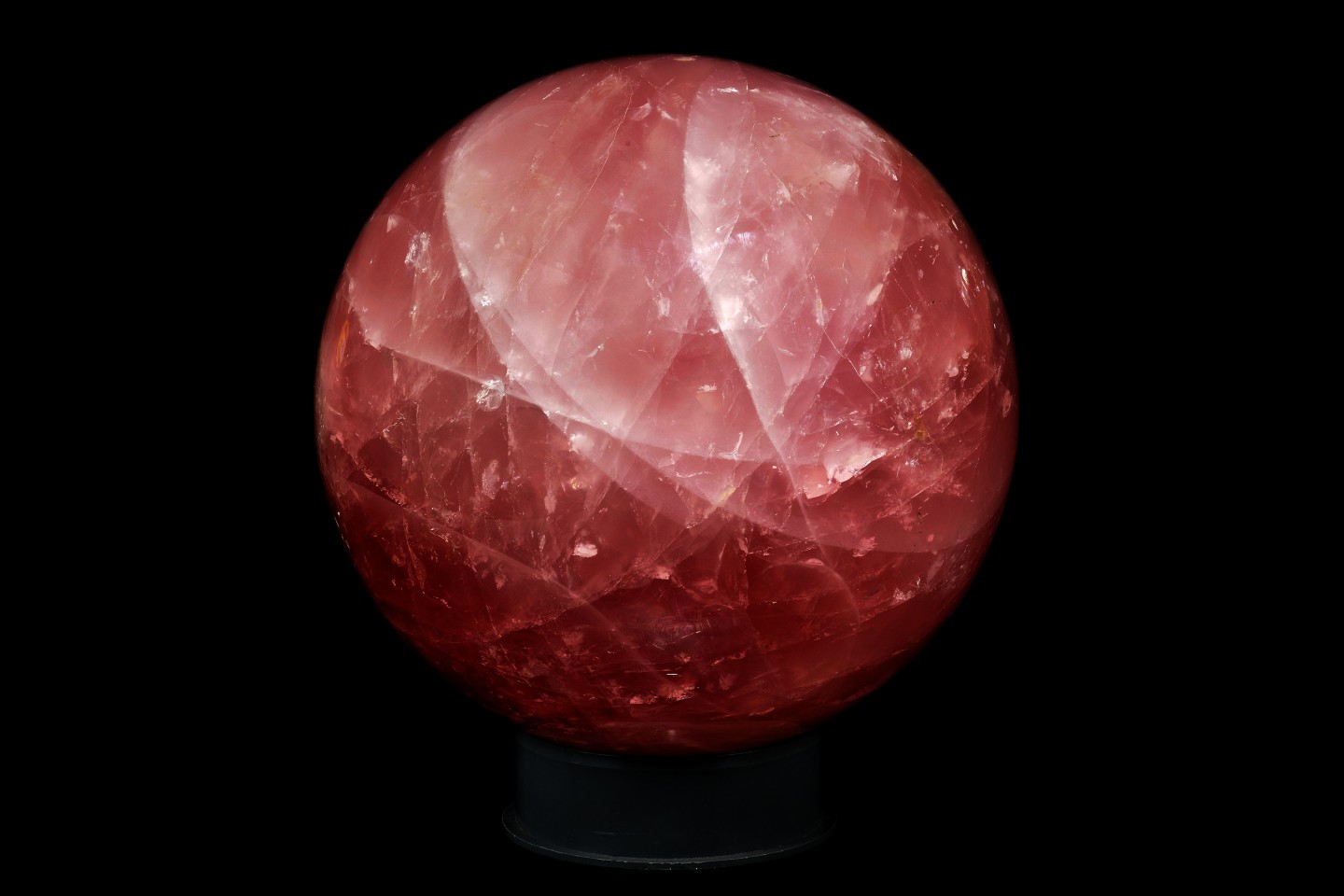
Christie’s
Christie’s Lot 108, May 21, 2020
Estimate: £5,000 – £8,000 (US$1000 – US$1500)
Quartz may well be the second most abundant mineral in Earth’s continental crust (behind feldspar), but it comes in many different and often quite beautiful colours thanks to trace amounts of other elements. It has been commonly used in the making of jewelry since antiquity, for obvious reasons.
Dronino Meteorite – Abstract Figure From Outer Space
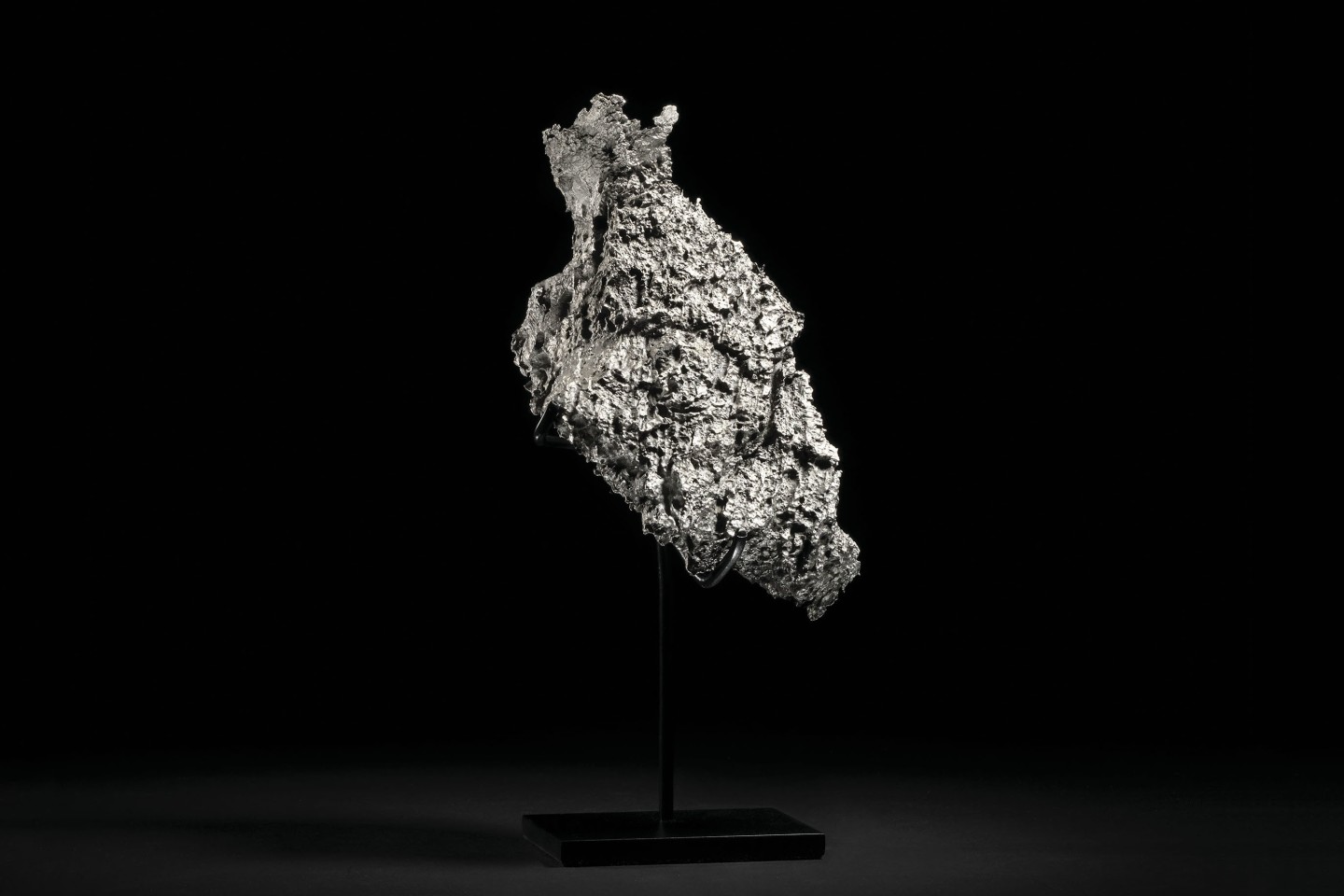
Christie’s
Christie’s, lot 39, May 21, 2020
Estimate: £5,000 – £8,000 (US$6,250 – US$10,000)
From the same Dronino meteorite shower mentioned previously in this article, Dronino meteorites are iron-rich meteorites boasting an exotic chemical composition. Whereas 89% of iron meteorites can be categorized within an established chemical group, the present specimens are not related to any of these groups. This curious material makeup suggests that they originated from a much larger parent asteroid that remains unknown. This metallic alien visitor has quite an enchanting presence well before its story of mystery is told.
Superb Sericho Pallasite End Cut
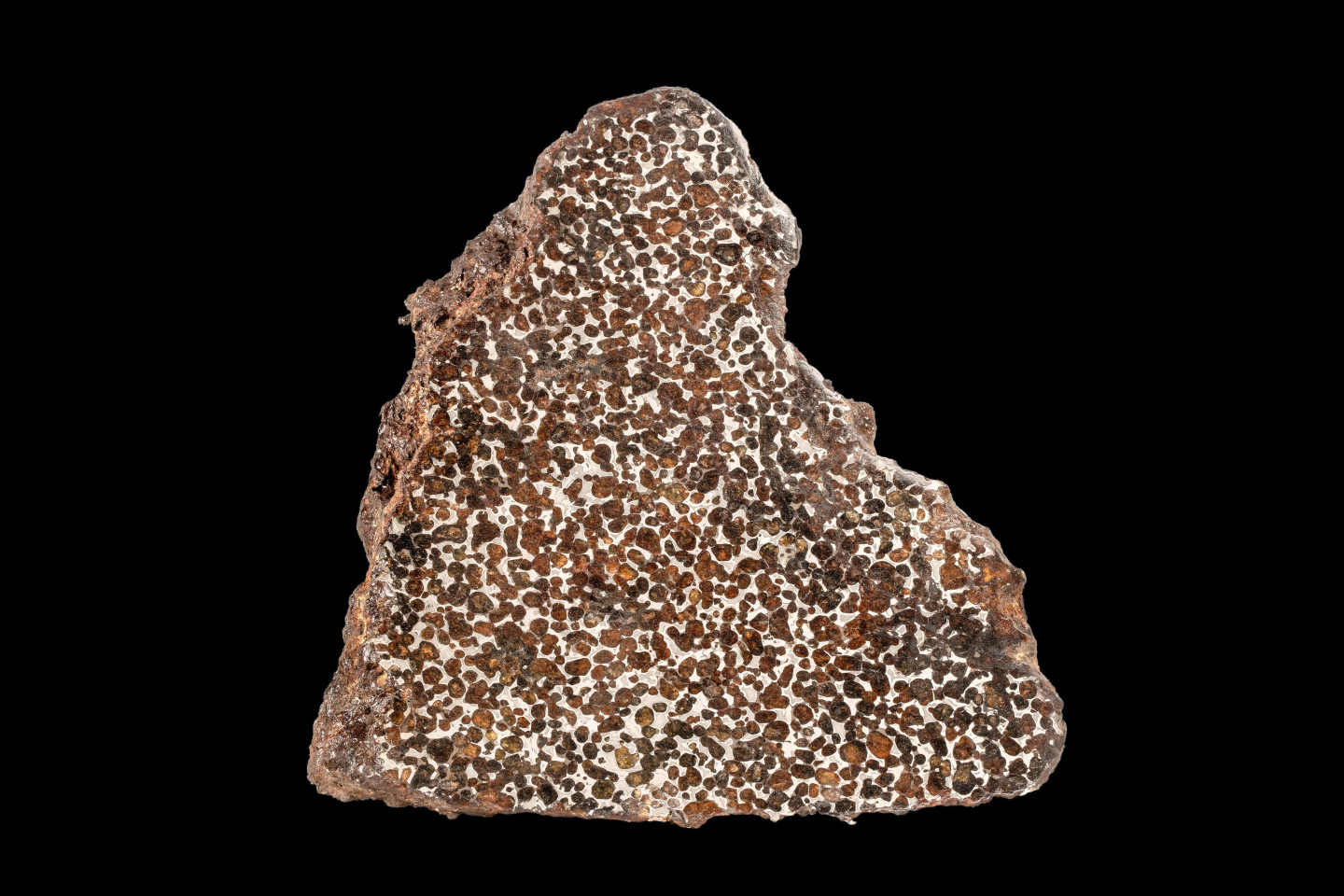
Bonhams
Bonhams, Lot 61, May 21, 2020
US$13,000 – US$16,000 (US$16,250 – US$20,000)
This recently discovered pallasite was found in Eastern Kenya in 2016, and the sliced end-piece has been polished and etched to show it’s remarkable Widmanstätten structure contrasted against abundant yellow to orange peridot crystals.
Source of Article